Digital Marketing Plan for British Council Myanmar
VerifiedAdded on 2023/04/21
|25
|8107
|479
AI Summary
This report outlines an effective digital marketing solution for the British Council of Myanmar, focusing on digital personalization. It addresses specific problems in the organization's digital marketing strategies and provides recommendations for improvement. The report also includes a budget and timeline for implementing the plan and discusses the limitations and privacy considerations.
Contribute Materials
Your contribution can guide someone’s learning journey. Share your
documents today.
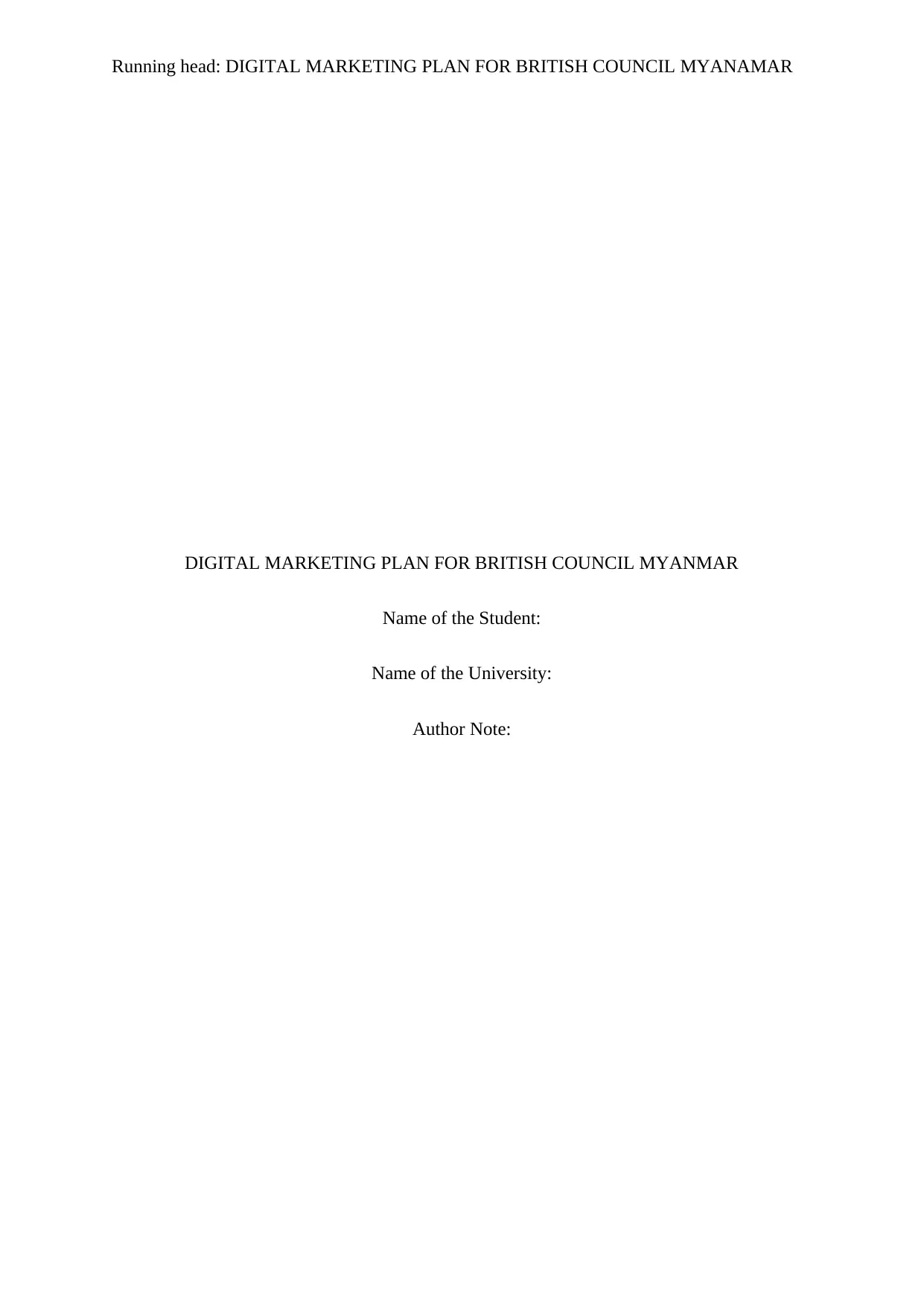
Running head: DIGITAL MARKETING PLAN FOR BRITISH COUNCIL MYANAMAR
DIGITAL MARKETING PLAN FOR BRITISH COUNCIL MYANMAR
Name of the Student:
Name of the University:
Author Note:
DIGITAL MARKETING PLAN FOR BRITISH COUNCIL MYANMAR
Name of the Student:
Name of the University:
Author Note:
Secure Best Marks with AI Grader
Need help grading? Try our AI Grader for instant feedback on your assignments.
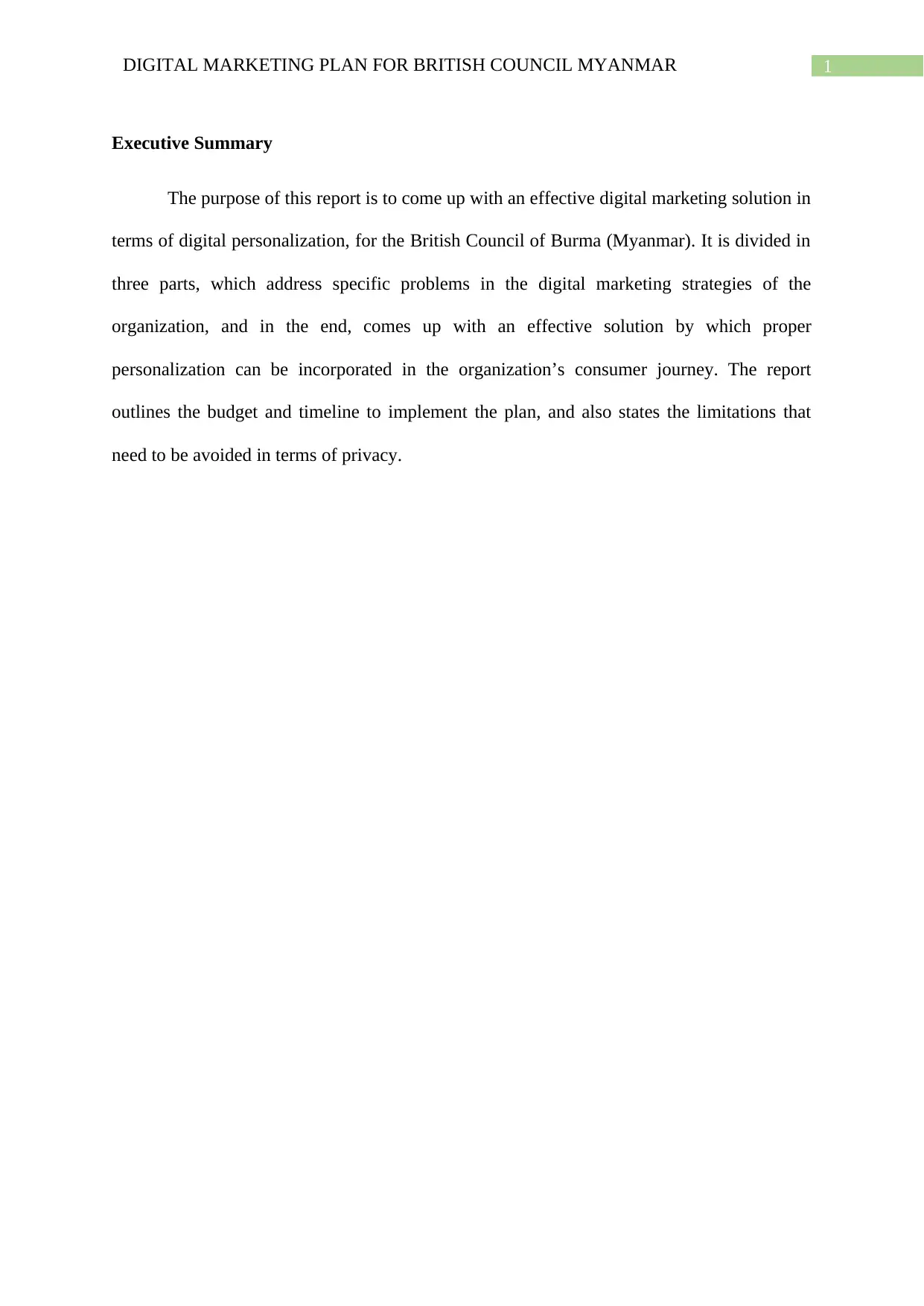
1DIGITAL MARKETING PLAN FOR BRITISH COUNCIL MYANMAR
Executive Summary
The purpose of this report is to come up with an effective digital marketing solution in
terms of digital personalization, for the British Council of Burma (Myanmar). It is divided in
three parts, which address specific problems in the digital marketing strategies of the
organization, and in the end, comes up with an effective solution by which proper
personalization can be incorporated in the organization’s consumer journey. The report
outlines the budget and timeline to implement the plan, and also states the limitations that
need to be avoided in terms of privacy.
Executive Summary
The purpose of this report is to come up with an effective digital marketing solution in
terms of digital personalization, for the British Council of Burma (Myanmar). It is divided in
three parts, which address specific problems in the digital marketing strategies of the
organization, and in the end, comes up with an effective solution by which proper
personalization can be incorporated in the organization’s consumer journey. The report
outlines the budget and timeline to implement the plan, and also states the limitations that
need to be avoided in terms of privacy.
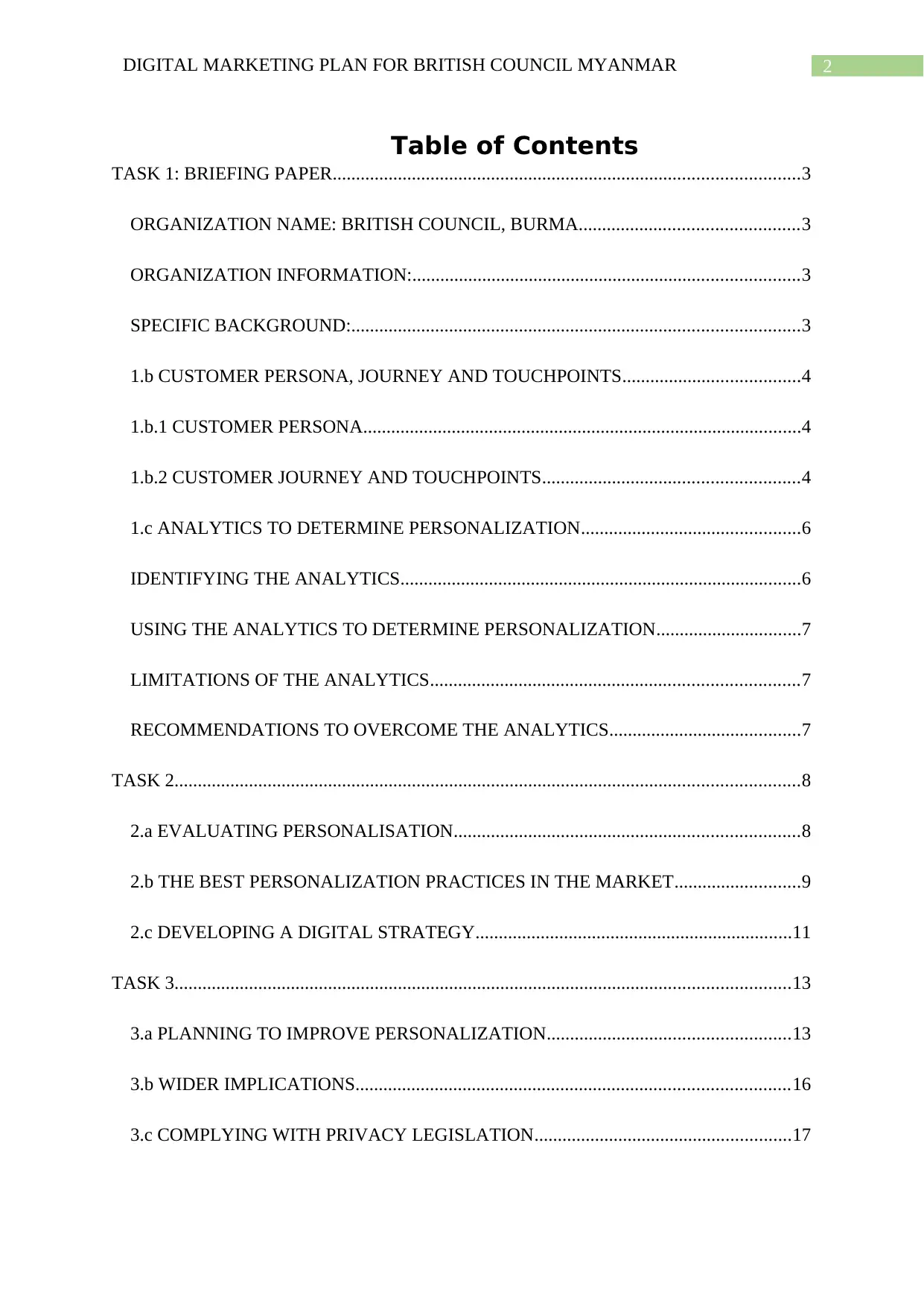
2DIGITAL MARKETING PLAN FOR BRITISH COUNCIL MYANMAR
Table of Contents
TASK 1: BRIEFING PAPER....................................................................................................3
ORGANIZATION NAME: BRITISH COUNCIL, BURMA...............................................3
ORGANIZATION INFORMATION:...................................................................................3
SPECIFIC BACKGROUND:................................................................................................3
1.b CUSTOMER PERSONA, JOURNEY AND TOUCHPOINTS......................................4
1.b.1 CUSTOMER PERSONA..............................................................................................4
1.b.2 CUSTOMER JOURNEY AND TOUCHPOINTS.......................................................4
1.c ANALYTICS TO DETERMINE PERSONALIZATION...............................................6
IDENTIFYING THE ANALYTICS......................................................................................6
USING THE ANALYTICS TO DETERMINE PERSONALIZATION...............................7
LIMITATIONS OF THE ANALYTICS...............................................................................7
RECOMMENDATIONS TO OVERCOME THE ANALYTICS.........................................7
TASK 2......................................................................................................................................8
2.a EVALUATING PERSONALISATION..........................................................................8
2.b THE BEST PERSONALIZATION PRACTICES IN THE MARKET...........................9
2.c DEVELOPING A DIGITAL STRATEGY....................................................................11
TASK 3....................................................................................................................................13
3.a PLANNING TO IMPROVE PERSONALIZATION....................................................13
3.b WIDER IMPLICATIONS.............................................................................................16
3.c COMPLYING WITH PRIVACY LEGISLATION.......................................................17
Table of Contents
TASK 1: BRIEFING PAPER....................................................................................................3
ORGANIZATION NAME: BRITISH COUNCIL, BURMA...............................................3
ORGANIZATION INFORMATION:...................................................................................3
SPECIFIC BACKGROUND:................................................................................................3
1.b CUSTOMER PERSONA, JOURNEY AND TOUCHPOINTS......................................4
1.b.1 CUSTOMER PERSONA..............................................................................................4
1.b.2 CUSTOMER JOURNEY AND TOUCHPOINTS.......................................................4
1.c ANALYTICS TO DETERMINE PERSONALIZATION...............................................6
IDENTIFYING THE ANALYTICS......................................................................................6
USING THE ANALYTICS TO DETERMINE PERSONALIZATION...............................7
LIMITATIONS OF THE ANALYTICS...............................................................................7
RECOMMENDATIONS TO OVERCOME THE ANALYTICS.........................................7
TASK 2......................................................................................................................................8
2.a EVALUATING PERSONALISATION..........................................................................8
2.b THE BEST PERSONALIZATION PRACTICES IN THE MARKET...........................9
2.c DEVELOPING A DIGITAL STRATEGY....................................................................11
TASK 3....................................................................................................................................13
3.a PLANNING TO IMPROVE PERSONALIZATION....................................................13
3.b WIDER IMPLICATIONS.............................................................................................16
3.c COMPLYING WITH PRIVACY LEGISLATION.......................................................17
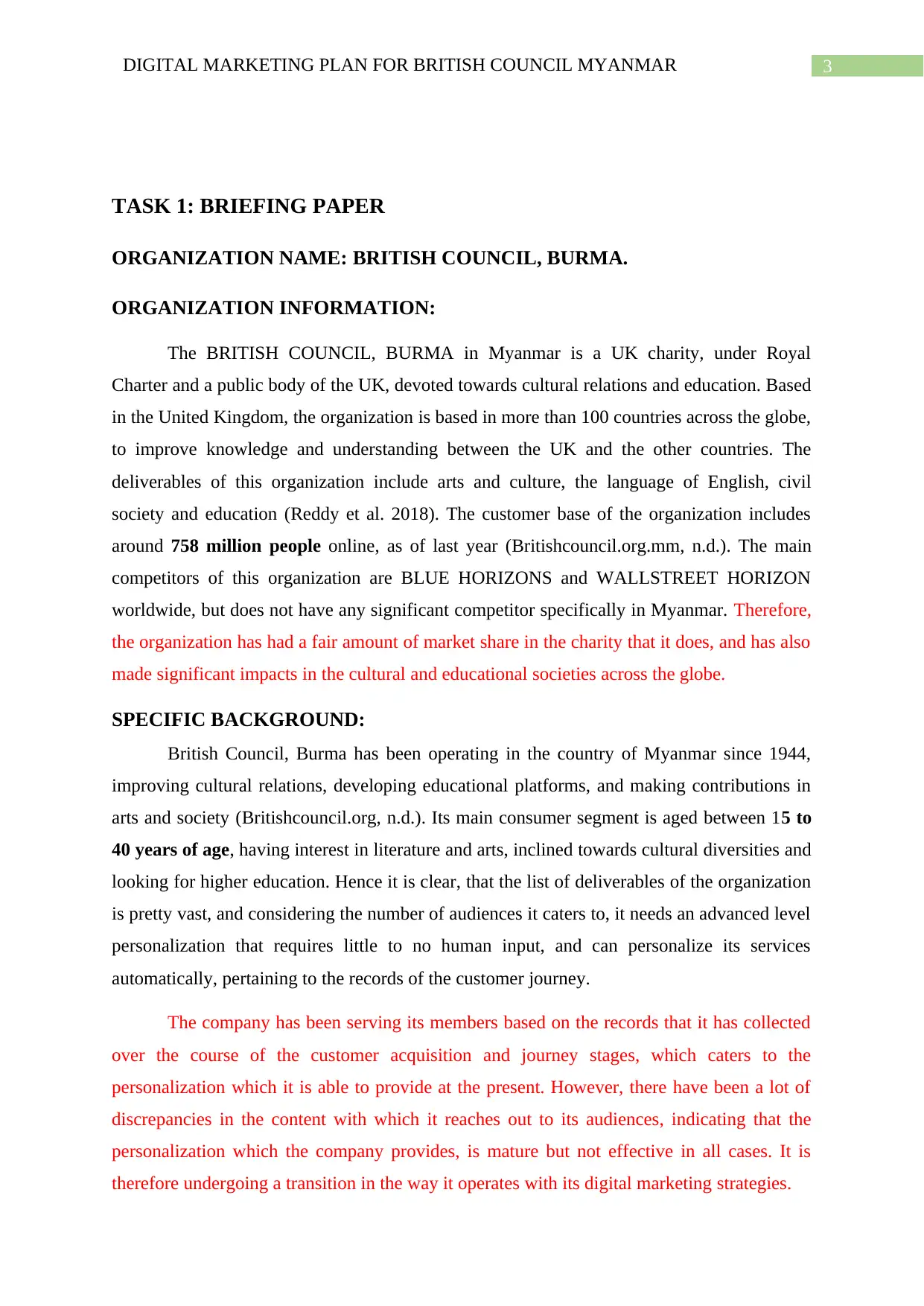
3DIGITAL MARKETING PLAN FOR BRITISH COUNCIL MYANMAR
TASK 1: BRIEFING PAPER
ORGANIZATION NAME: BRITISH COUNCIL, BURMA.
ORGANIZATION INFORMATION:
The BRITISH COUNCIL, BURMA in Myanmar is a UK charity, under Royal
Charter and a public body of the UK, devoted towards cultural relations and education. Based
in the United Kingdom, the organization is based in more than 100 countries across the globe,
to improve knowledge and understanding between the UK and the other countries. The
deliverables of this organization include arts and culture, the language of English, civil
society and education (Reddy et al. 2018). The customer base of the organization includes
around 758 million people online, as of last year (Britishcouncil.org.mm, n.d.). The main
competitors of this organization are BLUE HORIZONS and WALLSTREET HORIZON
worldwide, but does not have any significant competitor specifically in Myanmar. Therefore,
the organization has had a fair amount of market share in the charity that it does, and has also
made significant impacts in the cultural and educational societies across the globe.
SPECIFIC BACKGROUND:
British Council, Burma has been operating in the country of Myanmar since 1944,
improving cultural relations, developing educational platforms, and making contributions in
arts and society (Britishcouncil.org, n.d.). Its main consumer segment is aged between 15 to
40 years of age, having interest in literature and arts, inclined towards cultural diversities and
looking for higher education. Hence it is clear, that the list of deliverables of the organization
is pretty vast, and considering the number of audiences it caters to, it needs an advanced level
personalization that requires little to no human input, and can personalize its services
automatically, pertaining to the records of the customer journey.
The company has been serving its members based on the records that it has collected
over the course of the customer acquisition and journey stages, which caters to the
personalization which it is able to provide at the present. However, there have been a lot of
discrepancies in the content with which it reaches out to its audiences, indicating that the
personalization which the company provides, is mature but not effective in all cases. It is
therefore undergoing a transition in the way it operates with its digital marketing strategies.
TASK 1: BRIEFING PAPER
ORGANIZATION NAME: BRITISH COUNCIL, BURMA.
ORGANIZATION INFORMATION:
The BRITISH COUNCIL, BURMA in Myanmar is a UK charity, under Royal
Charter and a public body of the UK, devoted towards cultural relations and education. Based
in the United Kingdom, the organization is based in more than 100 countries across the globe,
to improve knowledge and understanding between the UK and the other countries. The
deliverables of this organization include arts and culture, the language of English, civil
society and education (Reddy et al. 2018). The customer base of the organization includes
around 758 million people online, as of last year (Britishcouncil.org.mm, n.d.). The main
competitors of this organization are BLUE HORIZONS and WALLSTREET HORIZON
worldwide, but does not have any significant competitor specifically in Myanmar. Therefore,
the organization has had a fair amount of market share in the charity that it does, and has also
made significant impacts in the cultural and educational societies across the globe.
SPECIFIC BACKGROUND:
British Council, Burma has been operating in the country of Myanmar since 1944,
improving cultural relations, developing educational platforms, and making contributions in
arts and society (Britishcouncil.org, n.d.). Its main consumer segment is aged between 15 to
40 years of age, having interest in literature and arts, inclined towards cultural diversities and
looking for higher education. Hence it is clear, that the list of deliverables of the organization
is pretty vast, and considering the number of audiences it caters to, it needs an advanced level
personalization that requires little to no human input, and can personalize its services
automatically, pertaining to the records of the customer journey.
The company has been serving its members based on the records that it has collected
over the course of the customer acquisition and journey stages, which caters to the
personalization which it is able to provide at the present. However, there have been a lot of
discrepancies in the content with which it reaches out to its audiences, indicating that the
personalization which the company provides, is mature but not effective in all cases. It is
therefore undergoing a transition in the way it operates with its digital marketing strategies.
Secure Best Marks with AI Grader
Need help grading? Try our AI Grader for instant feedback on your assignments.

4DIGITAL MARKETING PLAN FOR BRITISH COUNCIL MYANMAR
1.b CUSTOMER PERSONA, JOURNEY AND TOUCHPOINTS
From the key customer segment of the British Council in Burma, the customer
persona can be identified and described by using research methods on the same.
1.b.1 CUSTOMER PERSONA
Firstly, the people of Myanmar aged between 15 and 40 years are more dynamic in
nature than the rest of the age groups in the country (Elizabeth and Banks 2018). By dynamic,
it is meant that these people exhibit a high openness to experiences, and are usually energetic
in nature. Those having interest in literature and arts, tend to be intellectual and creative in
nature, showing interests in creative processes of learning such as debates and riddles, and
tend to contribute to the society in their respective fields as well.
Secondly, people of Myanmar who show an inclination towards cultural diversities,
have been observed to be more conscientious and open to experiences, while being highly
accepting of the multiculturalism in the country at the same time (Rich and Frank 2016).
Since the majority of this segment of the consumer base is older than the rest of the
population in the key consumer segment, these consumers often tend to be exploratory than
being indoors, having more free time than the busy young population of the country.
Thirdly, people looking for higher education in the country tend to move abroad
(Harcourt 2018). These people are highly keen on learning concepts related to their fields,
and are willing to grab on to attractive educational opportunities that they get at a reasonable
price.
Therefore, from the above research done on the key consumer segment of the
organization, it can be inferred that the customer persona of the customer base of British
Council, Burma, is that of an energetic and exploratory nature, tolerant towards
multiculturalism, inclined to learning and are highly open to experiences.
1.b.2 CUSTOMER JOURNEY AND TOUCHPOINTS
Customer journey on the other hand is the customer’s entire experience of interacting with
the organization throughout his or her engagement with the brand (Lemon and Verhoef
2016). The points of interactions of the customer with the brand are called customer
touchpoints (Bascur, Rusu and Quiñones 2018).
1.b CUSTOMER PERSONA, JOURNEY AND TOUCHPOINTS
From the key customer segment of the British Council in Burma, the customer
persona can be identified and described by using research methods on the same.
1.b.1 CUSTOMER PERSONA
Firstly, the people of Myanmar aged between 15 and 40 years are more dynamic in
nature than the rest of the age groups in the country (Elizabeth and Banks 2018). By dynamic,
it is meant that these people exhibit a high openness to experiences, and are usually energetic
in nature. Those having interest in literature and arts, tend to be intellectual and creative in
nature, showing interests in creative processes of learning such as debates and riddles, and
tend to contribute to the society in their respective fields as well.
Secondly, people of Myanmar who show an inclination towards cultural diversities,
have been observed to be more conscientious and open to experiences, while being highly
accepting of the multiculturalism in the country at the same time (Rich and Frank 2016).
Since the majority of this segment of the consumer base is older than the rest of the
population in the key consumer segment, these consumers often tend to be exploratory than
being indoors, having more free time than the busy young population of the country.
Thirdly, people looking for higher education in the country tend to move abroad
(Harcourt 2018). These people are highly keen on learning concepts related to their fields,
and are willing to grab on to attractive educational opportunities that they get at a reasonable
price.
Therefore, from the above research done on the key consumer segment of the
organization, it can be inferred that the customer persona of the customer base of British
Council, Burma, is that of an energetic and exploratory nature, tolerant towards
multiculturalism, inclined to learning and are highly open to experiences.
1.b.2 CUSTOMER JOURNEY AND TOUCHPOINTS
Customer journey on the other hand is the customer’s entire experience of interacting with
the organization throughout his or her engagement with the brand (Lemon and Verhoef
2016). The points of interactions of the customer with the brand are called customer
touchpoints (Bascur, Rusu and Quiñones 2018).
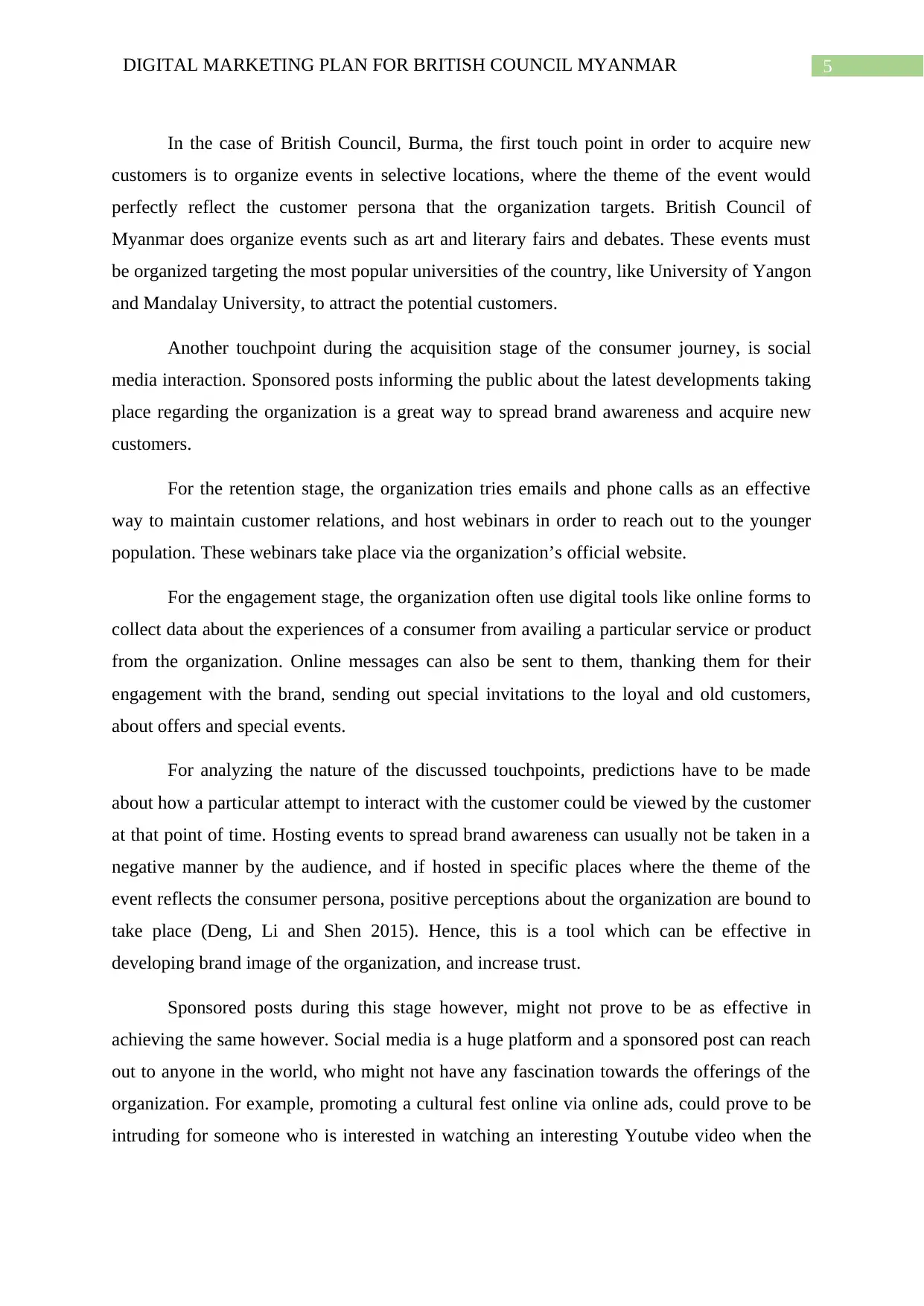
5DIGITAL MARKETING PLAN FOR BRITISH COUNCIL MYANMAR
In the case of British Council, Burma, the first touch point in order to acquire new
customers is to organize events in selective locations, where the theme of the event would
perfectly reflect the customer persona that the organization targets. British Council of
Myanmar does organize events such as art and literary fairs and debates. These events must
be organized targeting the most popular universities of the country, like University of Yangon
and Mandalay University, to attract the potential customers.
Another touchpoint during the acquisition stage of the consumer journey, is social
media interaction. Sponsored posts informing the public about the latest developments taking
place regarding the organization is a great way to spread brand awareness and acquire new
customers.
For the retention stage, the organization tries emails and phone calls as an effective
way to maintain customer relations, and host webinars in order to reach out to the younger
population. These webinars take place via the organization’s official website.
For the engagement stage, the organization often use digital tools like online forms to
collect data about the experiences of a consumer from availing a particular service or product
from the organization. Online messages can also be sent to them, thanking them for their
engagement with the brand, sending out special invitations to the loyal and old customers,
about offers and special events.
For analyzing the nature of the discussed touchpoints, predictions have to be made
about how a particular attempt to interact with the customer could be viewed by the customer
at that point of time. Hosting events to spread brand awareness can usually not be taken in a
negative manner by the audience, and if hosted in specific places where the theme of the
event reflects the consumer persona, positive perceptions about the organization are bound to
take place (Deng, Li and Shen 2015). Hence, this is a tool which can be effective in
developing brand image of the organization, and increase trust.
Sponsored posts during this stage however, might not prove to be as effective in
achieving the same however. Social media is a huge platform and a sponsored post can reach
out to anyone in the world, who might not have any fascination towards the offerings of the
organization. For example, promoting a cultural fest online via online ads, could prove to be
intruding for someone who is interested in watching an interesting Youtube video when the
In the case of British Council, Burma, the first touch point in order to acquire new
customers is to organize events in selective locations, where the theme of the event would
perfectly reflect the customer persona that the organization targets. British Council of
Myanmar does organize events such as art and literary fairs and debates. These events must
be organized targeting the most popular universities of the country, like University of Yangon
and Mandalay University, to attract the potential customers.
Another touchpoint during the acquisition stage of the consumer journey, is social
media interaction. Sponsored posts informing the public about the latest developments taking
place regarding the organization is a great way to spread brand awareness and acquire new
customers.
For the retention stage, the organization tries emails and phone calls as an effective
way to maintain customer relations, and host webinars in order to reach out to the younger
population. These webinars take place via the organization’s official website.
For the engagement stage, the organization often use digital tools like online forms to
collect data about the experiences of a consumer from availing a particular service or product
from the organization. Online messages can also be sent to them, thanking them for their
engagement with the brand, sending out special invitations to the loyal and old customers,
about offers and special events.
For analyzing the nature of the discussed touchpoints, predictions have to be made
about how a particular attempt to interact with the customer could be viewed by the customer
at that point of time. Hosting events to spread brand awareness can usually not be taken in a
negative manner by the audience, and if hosted in specific places where the theme of the
event reflects the consumer persona, positive perceptions about the organization are bound to
take place (Deng, Li and Shen 2015). Hence, this is a tool which can be effective in
developing brand image of the organization, and increase trust.
Sponsored posts during this stage however, might not prove to be as effective in
achieving the same however. Social media is a huge platform and a sponsored post can reach
out to anyone in the world, who might not have any fascination towards the offerings of the
organization. For example, promoting a cultural fest online via online ads, could prove to be
intruding for someone who is interested in watching an interesting Youtube video when the

6DIGITAL MARKETING PLAN FOR BRITISH COUNCIL MYANMAR
ad keeps him waiting for a while until it ends. In such cases, the viewer could get frustrated
and this particular touchpoint could prove to be a negative experience or a pain touchpoint.
In the next sage however, emails can be a very effective way of retaining a customer,
by staying in touch with him or her in an attempt to make the customer feel special about
choosing to purchase from the organization. It can also help the customer in staying updated
about the important information and developments regarding the organization. Hence, it can
enhance the trust between the two entities. For example, a book lover getting an update about
a nearby book fair taking place in the upcoming week.
Phone calls however, could be intruding for the customer. One may not like the
intrusive nature of a sudden phone call that he or she gets, during an important or busy time.
Hence, it can create an irritating experience for the customer.
Webinars are a selective way of engaging the audience as specific webinars will be
attracting audiences of specific interests. Hence, if managed and delivered effectively, a
webinar can prove to be a positive experience for a target consumer. Through to the retention
stage, online forms asking for a customer’s feedback are optional for any customer. Those
who want to provide a feedback would welcome it, and those uninterested would be ignoring
it. But, knowing that the organization cares about a customer’s experience, can only create a
positive image of the organization in the minds of the customers. This is often effective in
creating and/or enhancing trust in the organization.
Hence, from the predicting and analyzing how the various touchpoints could be
affecting the customer throughout the customer journey from acquisition to engagement, the
touchpoints could be classified in the following manner:
Trust touchpoints: online events, emails, webinars and online feedback forms.
Pain touchpoints: sponsored posts and ads, and phone calls.
1.c ANALYTICS TO DETERMINE PERSONALIZATION
To analyze the level of personalization through the stages of customer journey,
following is how analytics can be used:
IDENTIFYING THE ANALYTICS
The analytics that can be used to determine the level of personalization are polls and
surveys, and focus groups. Polls are questions which are sent out to target respondents with
ad keeps him waiting for a while until it ends. In such cases, the viewer could get frustrated
and this particular touchpoint could prove to be a negative experience or a pain touchpoint.
In the next sage however, emails can be a very effective way of retaining a customer,
by staying in touch with him or her in an attempt to make the customer feel special about
choosing to purchase from the organization. It can also help the customer in staying updated
about the important information and developments regarding the organization. Hence, it can
enhance the trust between the two entities. For example, a book lover getting an update about
a nearby book fair taking place in the upcoming week.
Phone calls however, could be intruding for the customer. One may not like the
intrusive nature of a sudden phone call that he or she gets, during an important or busy time.
Hence, it can create an irritating experience for the customer.
Webinars are a selective way of engaging the audience as specific webinars will be
attracting audiences of specific interests. Hence, if managed and delivered effectively, a
webinar can prove to be a positive experience for a target consumer. Through to the retention
stage, online forms asking for a customer’s feedback are optional for any customer. Those
who want to provide a feedback would welcome it, and those uninterested would be ignoring
it. But, knowing that the organization cares about a customer’s experience, can only create a
positive image of the organization in the minds of the customers. This is often effective in
creating and/or enhancing trust in the organization.
Hence, from the predicting and analyzing how the various touchpoints could be
affecting the customer throughout the customer journey from acquisition to engagement, the
touchpoints could be classified in the following manner:
Trust touchpoints: online events, emails, webinars and online feedback forms.
Pain touchpoints: sponsored posts and ads, and phone calls.
1.c ANALYTICS TO DETERMINE PERSONALIZATION
To analyze the level of personalization through the stages of customer journey,
following is how analytics can be used:
IDENTIFYING THE ANALYTICS
The analytics that can be used to determine the level of personalization are polls and
surveys, and focus groups. Polls are questions which are sent out to target respondents with
Paraphrase This Document
Need a fresh take? Get an instant paraphrase of this document with our AI Paraphraser

7DIGITAL MARKETING PLAN FOR BRITISH COUNCIL MYANMAR
specific options which the respondent can choose from as his or her reply to the question
(Sajuria and Fábrega 2016). Surveys can contain tools like that of a questionnaire, designed
to collect information from a group of people or from an area, which can be further analyzed
to quantify or qualify the data.
USING THE ANALYTICS TO DETERMINE PERSONALIZATION
Polls and survey questions, including focus group interviews could be designed in a
way that asks about a person’s interest, whether cultural, arts and literature, or educational,
and questions the respondent whether he has received mails, or phone calls pertaining to the
information related to the organization that coincides with his interest (Morgan and Hoffman
2018). This data can be then analyzed on the basis of how many people did not actually
receive information relating to his or her areas of interests, and possibly also on how many
kept receiving mails that had nothing to do with his interests. This can indicate the level of
personalization that exists in the customer experience. The most important thing to note here
is the fact that the purpose of the analytics is to measure the personalization level. Therefore,
they should be designed in a way in which the qualitative data which would be gathered from
the analytics would be perfectly reflective of the quantitative level of personalization upon
evaluation. Questions should be very much objective regarding the interests of the customers,
and the choices in the questionnaires should only include the services which the organization
provides to its customers. The responses should be measured in degrees; for example, on a
scale of one to six, based on the level of the agreeableness of the customer.
LIMITATIONS OF THE ANALYTICS
However, this could eventually prove to be a futile analysis, since respondents can
very well ignore the questionnaires and polls altogether (Keeter et al. 2017). On top of that,
the polls might not be representative, and customers of one domain could be much more
responsive than the customers of any other domain in the process. Hence, the entire process
of the analysis could become very unrepresentative in nature. This is because it would lead to
more data pertaining to a specific segment of the services which the company provides, and
not encompass the entirety of its services. Therefore, it would not be able to effectively aid in
measuring the personalization level of the organization’s services.
RECOMMENDATIONS TO OVERCOME THE ANALYTICS
To make the analysis and data collection more effective and useful, stress should be
given on pre-determining the areas of interests of the customers form the records, and then
specific options which the respondent can choose from as his or her reply to the question
(Sajuria and Fábrega 2016). Surveys can contain tools like that of a questionnaire, designed
to collect information from a group of people or from an area, which can be further analyzed
to quantify or qualify the data.
USING THE ANALYTICS TO DETERMINE PERSONALIZATION
Polls and survey questions, including focus group interviews could be designed in a
way that asks about a person’s interest, whether cultural, arts and literature, or educational,
and questions the respondent whether he has received mails, or phone calls pertaining to the
information related to the organization that coincides with his interest (Morgan and Hoffman
2018). This data can be then analyzed on the basis of how many people did not actually
receive information relating to his or her areas of interests, and possibly also on how many
kept receiving mails that had nothing to do with his interests. This can indicate the level of
personalization that exists in the customer experience. The most important thing to note here
is the fact that the purpose of the analytics is to measure the personalization level. Therefore,
they should be designed in a way in which the qualitative data which would be gathered from
the analytics would be perfectly reflective of the quantitative level of personalization upon
evaluation. Questions should be very much objective regarding the interests of the customers,
and the choices in the questionnaires should only include the services which the organization
provides to its customers. The responses should be measured in degrees; for example, on a
scale of one to six, based on the level of the agreeableness of the customer.
LIMITATIONS OF THE ANALYTICS
However, this could eventually prove to be a futile analysis, since respondents can
very well ignore the questionnaires and polls altogether (Keeter et al. 2017). On top of that,
the polls might not be representative, and customers of one domain could be much more
responsive than the customers of any other domain in the process. Hence, the entire process
of the analysis could become very unrepresentative in nature. This is because it would lead to
more data pertaining to a specific segment of the services which the company provides, and
not encompass the entirety of its services. Therefore, it would not be able to effectively aid in
measuring the personalization level of the organization’s services.
RECOMMENDATIONS TO OVERCOME THE ANALYTICS
To make the analysis and data collection more effective and useful, stress should be
given on pre-determining the areas of interests of the customers form the records, and then

8DIGITAL MARKETING PLAN FOR BRITISH COUNCIL MYANMAR
polls and questionnaires to them proportionately, such that equal chances of receiving a
response from each type of customer remains.
TASK 2
2.a EVALUATING PERSONALISATION
Based on the touchpoints identified in 1(b), they need to be evaluated on the basis of
how effective they are personalized for the customers, to get an overall evaluation of the
existing personalization.
As a trust touchpoint, online events do play a very effective role in acquiring new
customers (Harmeling et al. 2017). However, these cannot be termed as highly personalized
since these events can reach out to people from various domains. Hence, there is no guarantee
that a person interested in a specific domain will be exclusively a part of that special event.
Mails are mostly personalized by the organization, targeting customers interested in
each domain, specifically and separately. These mails are generally sent out to customers on
the basis of the interests that they tend to show in the records of the organization. Therefore,
specific mails concerning specific fields of interests can be effectively sent out for a better
consumer experience and response. These mails can either be promotional or relational,
which anyway prove to be useful for the recipient because of the personalized nature of these
mails.
Webinars too, are highly personalized. These webinars are only based on specific
domains, and people interested in those specific domains can watch it on demand (Semingson
et al. 2016). Therefore, these are catering to the people who are interested in the topics. By
far, the British Council of Myanmar has conducted over 500 webinars, and has attracted
viewers not only from Myanmar, but from all over the world, thereby proving its
effectiveness.
polls and questionnaires to them proportionately, such that equal chances of receiving a
response from each type of customer remains.
TASK 2
2.a EVALUATING PERSONALISATION
Based on the touchpoints identified in 1(b), they need to be evaluated on the basis of
how effective they are personalized for the customers, to get an overall evaluation of the
existing personalization.
As a trust touchpoint, online events do play a very effective role in acquiring new
customers (Harmeling et al. 2017). However, these cannot be termed as highly personalized
since these events can reach out to people from various domains. Hence, there is no guarantee
that a person interested in a specific domain will be exclusively a part of that special event.
Mails are mostly personalized by the organization, targeting customers interested in
each domain, specifically and separately. These mails are generally sent out to customers on
the basis of the interests that they tend to show in the records of the organization. Therefore,
specific mails concerning specific fields of interests can be effectively sent out for a better
consumer experience and response. These mails can either be promotional or relational,
which anyway prove to be useful for the recipient because of the personalized nature of these
mails.
Webinars too, are highly personalized. These webinars are only based on specific
domains, and people interested in those specific domains can watch it on demand (Semingson
et al. 2016). Therefore, these are catering to the people who are interested in the topics. By
far, the British Council of Myanmar has conducted over 500 webinars, and has attracted
viewers not only from Myanmar, but from all over the world, thereby proving its
effectiveness.

9DIGITAL MARKETING PLAN FOR BRITISH COUNCIL MYANMAR
British Council Personalized Webinars
(Source: Britishcouncil.co.uk)
Online feedback forms too are highly personalized. This is because the respondent is
receiving feedback only on the service that he or she has availed from the organization. Since
a customer would only avail services that he is interested in from the organization, these
feedback forms prove to be highly personalized in nature even if the interest of the customer
is unknown to the organization. Therefore, these forms are able to record specific information
about specific domains or public interest, which can be used to further analyze shortcomings
from a service.
Pain touch points such as sponsored ads and posts are highly unpersonalized in nature.
This is because of the same reason that makes online events a badly personalized tool for
interaction. The internet being a vast platform, can reach out to a diverse set of people from
all across the globe. Hence, different cultures may view the ads differently, depending on the
background of the viewer. This proves to be ineffective in targeting appropriate audiences
with appropriate messages.
Phone calls may or may not be personalized, depending on the purpose of the call. A
phone call can be personalized if it is for the purpose of getting feedback from the customer
about a particular experience. On the other hand, if it is for a promotional purpose and is done
without proper knowledge about the customer’s interests, it is a negative experience for a
customer and is not personalized in any manner (Piccinini et al. 2015).
British Council Personalized Webinars
(Source: Britishcouncil.co.uk)
Online feedback forms too are highly personalized. This is because the respondent is
receiving feedback only on the service that he or she has availed from the organization. Since
a customer would only avail services that he is interested in from the organization, these
feedback forms prove to be highly personalized in nature even if the interest of the customer
is unknown to the organization. Therefore, these forms are able to record specific information
about specific domains or public interest, which can be used to further analyze shortcomings
from a service.
Pain touch points such as sponsored ads and posts are highly unpersonalized in nature.
This is because of the same reason that makes online events a badly personalized tool for
interaction. The internet being a vast platform, can reach out to a diverse set of people from
all across the globe. Hence, different cultures may view the ads differently, depending on the
background of the viewer. This proves to be ineffective in targeting appropriate audiences
with appropriate messages.
Phone calls may or may not be personalized, depending on the purpose of the call. A
phone call can be personalized if it is for the purpose of getting feedback from the customer
about a particular experience. On the other hand, if it is for a promotional purpose and is done
without proper knowledge about the customer’s interests, it is a negative experience for a
customer and is not personalized in any manner (Piccinini et al. 2015).
Secure Best Marks with AI Grader
Need help grading? Try our AI Grader for instant feedback on your assignments.
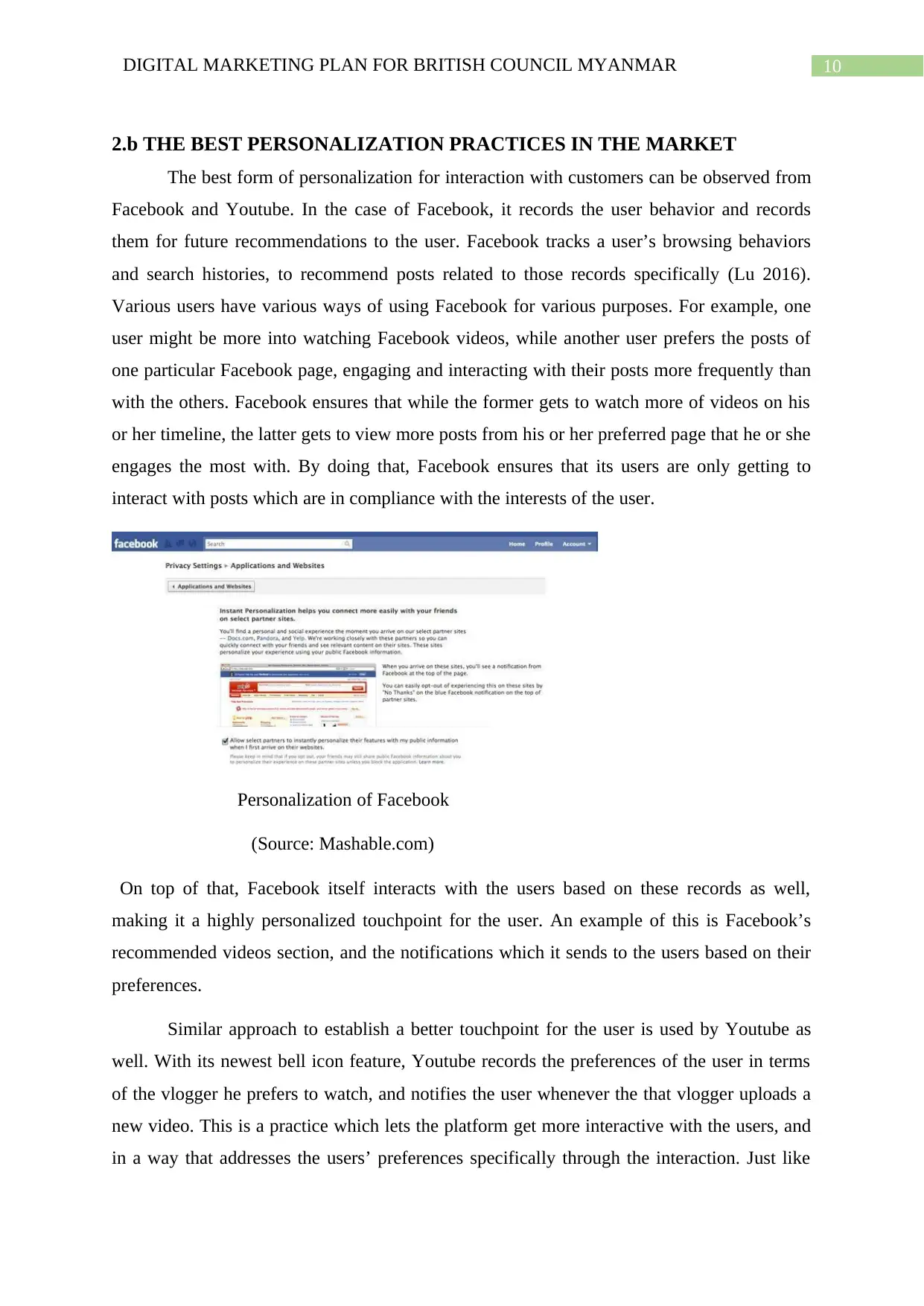
10DIGITAL MARKETING PLAN FOR BRITISH COUNCIL MYANMAR
2.b THE BEST PERSONALIZATION PRACTICES IN THE MARKET
The best form of personalization for interaction with customers can be observed from
Facebook and Youtube. In the case of Facebook, it records the user behavior and records
them for future recommendations to the user. Facebook tracks a user’s browsing behaviors
and search histories, to recommend posts related to those records specifically (Lu 2016).
Various users have various ways of using Facebook for various purposes. For example, one
user might be more into watching Facebook videos, while another user prefers the posts of
one particular Facebook page, engaging and interacting with their posts more frequently than
with the others. Facebook ensures that while the former gets to watch more of videos on his
or her timeline, the latter gets to view more posts from his or her preferred page that he or she
engages the most with. By doing that, Facebook ensures that its users are only getting to
interact with posts which are in compliance with the interests of the user.
Personalization of Facebook
(Source: Mashable.com)
On top of that, Facebook itself interacts with the users based on these records as well,
making it a highly personalized touchpoint for the user. An example of this is Facebook’s
recommended videos section, and the notifications which it sends to the users based on their
preferences.
Similar approach to establish a better touchpoint for the user is used by Youtube as
well. With its newest bell icon feature, Youtube records the preferences of the user in terms
of the vlogger he prefers to watch, and notifies the user whenever the that vlogger uploads a
new video. This is a practice which lets the platform get more interactive with the users, and
in a way that addresses the users’ preferences specifically through the interaction. Just like
2.b THE BEST PERSONALIZATION PRACTICES IN THE MARKET
The best form of personalization for interaction with customers can be observed from
Facebook and Youtube. In the case of Facebook, it records the user behavior and records
them for future recommendations to the user. Facebook tracks a user’s browsing behaviors
and search histories, to recommend posts related to those records specifically (Lu 2016).
Various users have various ways of using Facebook for various purposes. For example, one
user might be more into watching Facebook videos, while another user prefers the posts of
one particular Facebook page, engaging and interacting with their posts more frequently than
with the others. Facebook ensures that while the former gets to watch more of videos on his
or her timeline, the latter gets to view more posts from his or her preferred page that he or she
engages the most with. By doing that, Facebook ensures that its users are only getting to
interact with posts which are in compliance with the interests of the user.
Personalization of Facebook
(Source: Mashable.com)
On top of that, Facebook itself interacts with the users based on these records as well,
making it a highly personalized touchpoint for the user. An example of this is Facebook’s
recommended videos section, and the notifications which it sends to the users based on their
preferences.
Similar approach to establish a better touchpoint for the user is used by Youtube as
well. With its newest bell icon feature, Youtube records the preferences of the user in terms
of the vlogger he prefers to watch, and notifies the user whenever the that vlogger uploads a
new video. This is a practice which lets the platform get more interactive with the users, and
in a way that addresses the users’ preferences specifically through the interaction. Just like
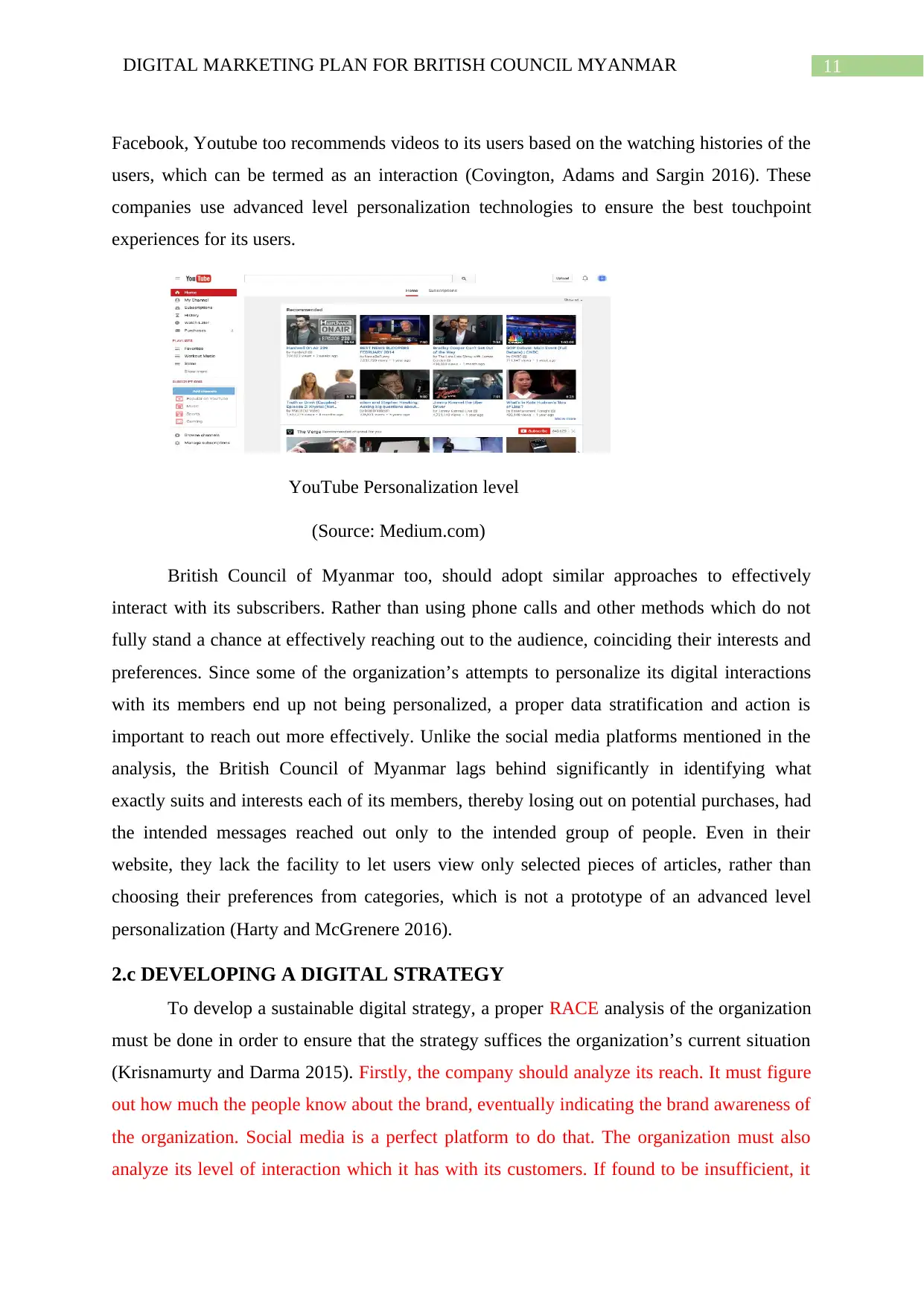
11DIGITAL MARKETING PLAN FOR BRITISH COUNCIL MYANMAR
Facebook, Youtube too recommends videos to its users based on the watching histories of the
users, which can be termed as an interaction (Covington, Adams and Sargin 2016). These
companies use advanced level personalization technologies to ensure the best touchpoint
experiences for its users.
YouTube Personalization level
(Source: Medium.com)
British Council of Myanmar too, should adopt similar approaches to effectively
interact with its subscribers. Rather than using phone calls and other methods which do not
fully stand a chance at effectively reaching out to the audience, coinciding their interests and
preferences. Since some of the organization’s attempts to personalize its digital interactions
with its members end up not being personalized, a proper data stratification and action is
important to reach out more effectively. Unlike the social media platforms mentioned in the
analysis, the British Council of Myanmar lags behind significantly in identifying what
exactly suits and interests each of its members, thereby losing out on potential purchases, had
the intended messages reached out only to the intended group of people. Even in their
website, they lack the facility to let users view only selected pieces of articles, rather than
choosing their preferences from categories, which is not a prototype of an advanced level
personalization (Harty and McGrenere 2016).
2.c DEVELOPING A DIGITAL STRATEGY
To develop a sustainable digital strategy, a proper RACE analysis of the organization
must be done in order to ensure that the strategy suffices the organization’s current situation
(Krisnamurty and Darma 2015). Firstly, the company should analyze its reach. It must figure
out how much the people know about the brand, eventually indicating the brand awareness of
the organization. Social media is a perfect platform to do that. The organization must also
analyze its level of interaction which it has with its customers. If found to be insufficient, it
Facebook, Youtube too recommends videos to its users based on the watching histories of the
users, which can be termed as an interaction (Covington, Adams and Sargin 2016). These
companies use advanced level personalization technologies to ensure the best touchpoint
experiences for its users.
YouTube Personalization level
(Source: Medium.com)
British Council of Myanmar too, should adopt similar approaches to effectively
interact with its subscribers. Rather than using phone calls and other methods which do not
fully stand a chance at effectively reaching out to the audience, coinciding their interests and
preferences. Since some of the organization’s attempts to personalize its digital interactions
with its members end up not being personalized, a proper data stratification and action is
important to reach out more effectively. Unlike the social media platforms mentioned in the
analysis, the British Council of Myanmar lags behind significantly in identifying what
exactly suits and interests each of its members, thereby losing out on potential purchases, had
the intended messages reached out only to the intended group of people. Even in their
website, they lack the facility to let users view only selected pieces of articles, rather than
choosing their preferences from categories, which is not a prototype of an advanced level
personalization (Harty and McGrenere 2016).
2.c DEVELOPING A DIGITAL STRATEGY
To develop a sustainable digital strategy, a proper RACE analysis of the organization
must be done in order to ensure that the strategy suffices the organization’s current situation
(Krisnamurty and Darma 2015). Firstly, the company should analyze its reach. It must figure
out how much the people know about the brand, eventually indicating the brand awareness of
the organization. Social media is a perfect platform to do that. The organization must also
analyze its level of interaction which it has with its customers. If found to be insufficient, it
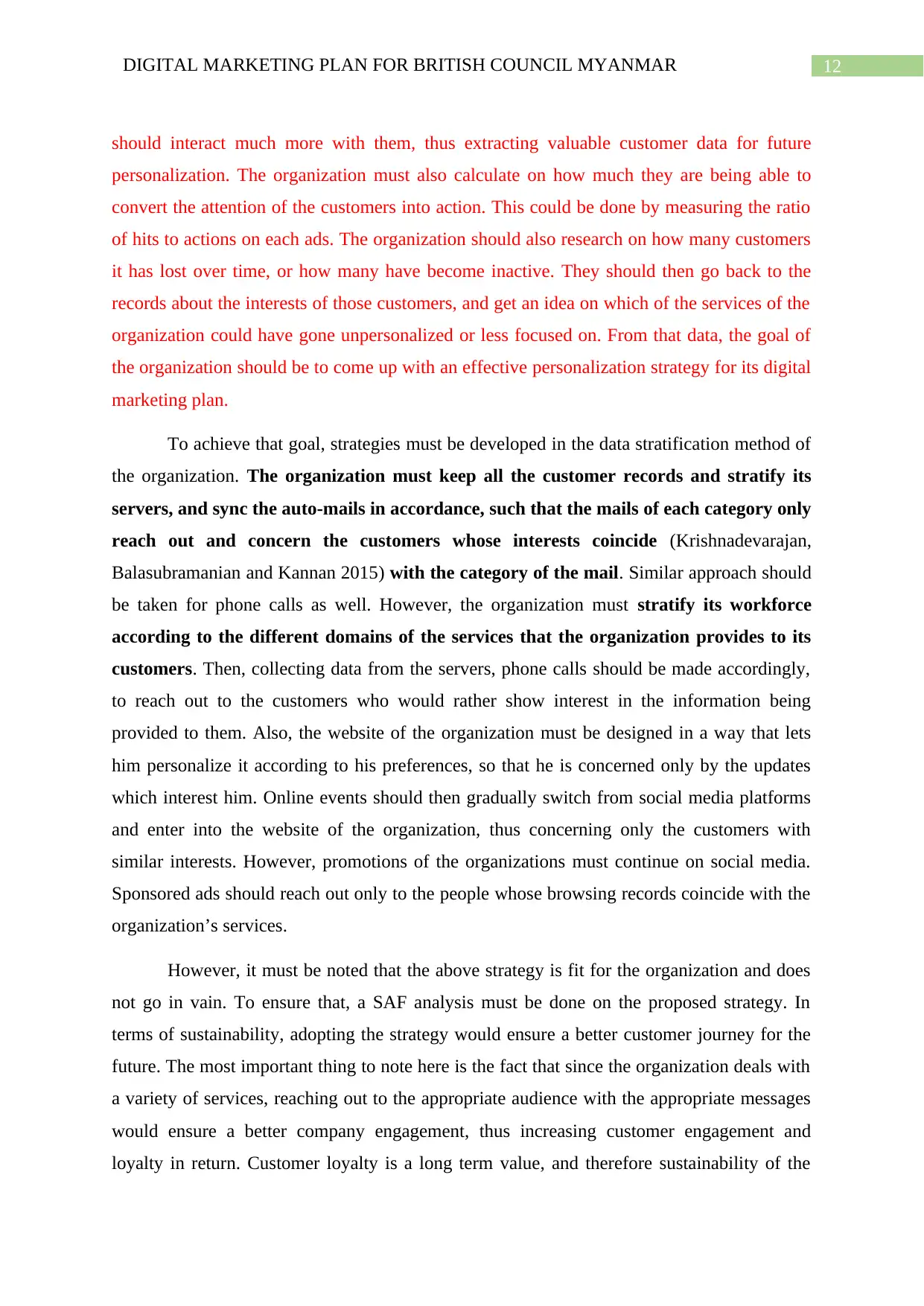
12DIGITAL MARKETING PLAN FOR BRITISH COUNCIL MYANMAR
should interact much more with them, thus extracting valuable customer data for future
personalization. The organization must also calculate on how much they are being able to
convert the attention of the customers into action. This could be done by measuring the ratio
of hits to actions on each ads. The organization should also research on how many customers
it has lost over time, or how many have become inactive. They should then go back to the
records about the interests of those customers, and get an idea on which of the services of the
organization could have gone unpersonalized or less focused on. From that data, the goal of
the organization should be to come up with an effective personalization strategy for its digital
marketing plan.
To achieve that goal, strategies must be developed in the data stratification method of
the organization. The organization must keep all the customer records and stratify its
servers, and sync the auto-mails in accordance, such that the mails of each category only
reach out and concern the customers whose interests coincide (Krishnadevarajan,
Balasubramanian and Kannan 2015) with the category of the mail. Similar approach should
be taken for phone calls as well. However, the organization must stratify its workforce
according to the different domains of the services that the organization provides to its
customers. Then, collecting data from the servers, phone calls should be made accordingly,
to reach out to the customers who would rather show interest in the information being
provided to them. Also, the website of the organization must be designed in a way that lets
him personalize it according to his preferences, so that he is concerned only by the updates
which interest him. Online events should then gradually switch from social media platforms
and enter into the website of the organization, thus concerning only the customers with
similar interests. However, promotions of the organizations must continue on social media.
Sponsored ads should reach out only to the people whose browsing records coincide with the
organization’s services.
However, it must be noted that the above strategy is fit for the organization and does
not go in vain. To ensure that, a SAF analysis must be done on the proposed strategy. In
terms of sustainability, adopting the strategy would ensure a better customer journey for the
future. The most important thing to note here is the fact that since the organization deals with
a variety of services, reaching out to the appropriate audience with the appropriate messages
would ensure a better company engagement, thus increasing customer engagement and
loyalty in return. Customer loyalty is a long term value, and therefore sustainability of the
should interact much more with them, thus extracting valuable customer data for future
personalization. The organization must also calculate on how much they are being able to
convert the attention of the customers into action. This could be done by measuring the ratio
of hits to actions on each ads. The organization should also research on how many customers
it has lost over time, or how many have become inactive. They should then go back to the
records about the interests of those customers, and get an idea on which of the services of the
organization could have gone unpersonalized or less focused on. From that data, the goal of
the organization should be to come up with an effective personalization strategy for its digital
marketing plan.
To achieve that goal, strategies must be developed in the data stratification method of
the organization. The organization must keep all the customer records and stratify its
servers, and sync the auto-mails in accordance, such that the mails of each category only
reach out and concern the customers whose interests coincide (Krishnadevarajan,
Balasubramanian and Kannan 2015) with the category of the mail. Similar approach should
be taken for phone calls as well. However, the organization must stratify its workforce
according to the different domains of the services that the organization provides to its
customers. Then, collecting data from the servers, phone calls should be made accordingly,
to reach out to the customers who would rather show interest in the information being
provided to them. Also, the website of the organization must be designed in a way that lets
him personalize it according to his preferences, so that he is concerned only by the updates
which interest him. Online events should then gradually switch from social media platforms
and enter into the website of the organization, thus concerning only the customers with
similar interests. However, promotions of the organizations must continue on social media.
Sponsored ads should reach out only to the people whose browsing records coincide with the
organization’s services.
However, it must be noted that the above strategy is fit for the organization and does
not go in vain. To ensure that, a SAF analysis must be done on the proposed strategy. In
terms of sustainability, adopting the strategy would ensure a better customer journey for the
future. The most important thing to note here is the fact that since the organization deals with
a variety of services, reaching out to the appropriate audience with the appropriate messages
would ensure a better company engagement, thus increasing customer engagement and
loyalty in return. Customer loyalty is a long term value, and therefore sustainability of the
Paraphrase This Document
Need a fresh take? Get an instant paraphrase of this document with our AI Paraphraser
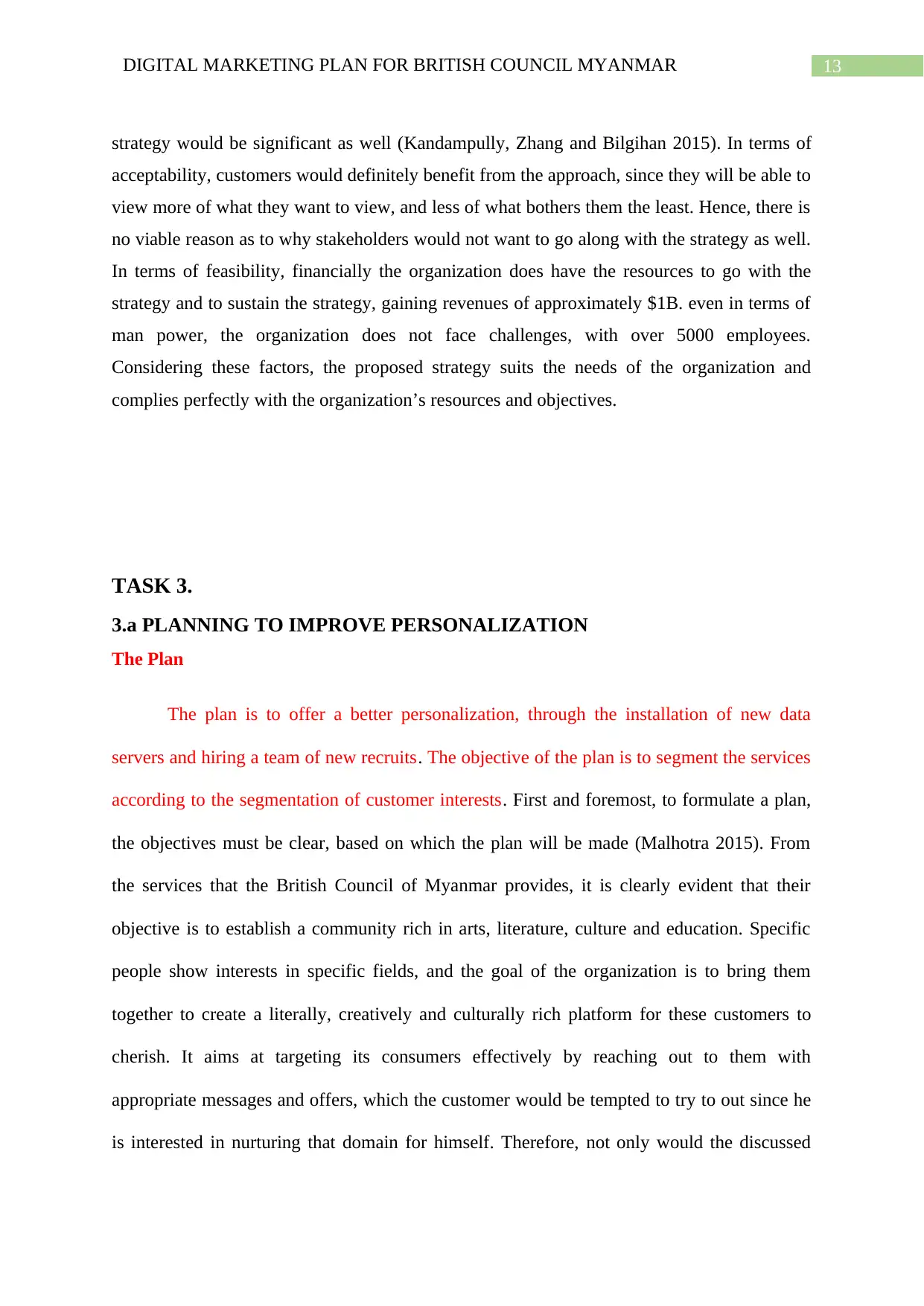
13DIGITAL MARKETING PLAN FOR BRITISH COUNCIL MYANMAR
strategy would be significant as well (Kandampully, Zhang and Bilgihan 2015). In terms of
acceptability, customers would definitely benefit from the approach, since they will be able to
view more of what they want to view, and less of what bothers them the least. Hence, there is
no viable reason as to why stakeholders would not want to go along with the strategy as well.
In terms of feasibility, financially the organization does have the resources to go with the
strategy and to sustain the strategy, gaining revenues of approximately $1B. even in terms of
man power, the organization does not face challenges, with over 5000 employees.
Considering these factors, the proposed strategy suits the needs of the organization and
complies perfectly with the organization’s resources and objectives.
TASK 3.
3.a PLANNING TO IMPROVE PERSONALIZATION
The Plan
The plan is to offer a better personalization, through the installation of new data
servers and hiring a team of new recruits. The objective of the plan is to segment the services
according to the segmentation of customer interests. First and foremost, to formulate a plan,
the objectives must be clear, based on which the plan will be made (Malhotra 2015). From
the services that the British Council of Myanmar provides, it is clearly evident that their
objective is to establish a community rich in arts, literature, culture and education. Specific
people show interests in specific fields, and the goal of the organization is to bring them
together to create a literally, creatively and culturally rich platform for these customers to
cherish. It aims at targeting its consumers effectively by reaching out to them with
appropriate messages and offers, which the customer would be tempted to try to out since he
is interested in nurturing that domain for himself. Therefore, not only would the discussed
strategy would be significant as well (Kandampully, Zhang and Bilgihan 2015). In terms of
acceptability, customers would definitely benefit from the approach, since they will be able to
view more of what they want to view, and less of what bothers them the least. Hence, there is
no viable reason as to why stakeholders would not want to go along with the strategy as well.
In terms of feasibility, financially the organization does have the resources to go with the
strategy and to sustain the strategy, gaining revenues of approximately $1B. even in terms of
man power, the organization does not face challenges, with over 5000 employees.
Considering these factors, the proposed strategy suits the needs of the organization and
complies perfectly with the organization’s resources and objectives.
TASK 3.
3.a PLANNING TO IMPROVE PERSONALIZATION
The Plan
The plan is to offer a better personalization, through the installation of new data
servers and hiring a team of new recruits. The objective of the plan is to segment the services
according to the segmentation of customer interests. First and foremost, to formulate a plan,
the objectives must be clear, based on which the plan will be made (Malhotra 2015). From
the services that the British Council of Myanmar provides, it is clearly evident that their
objective is to establish a community rich in arts, literature, culture and education. Specific
people show interests in specific fields, and the goal of the organization is to bring them
together to create a literally, creatively and culturally rich platform for these customers to
cherish. It aims at targeting its consumers effectively by reaching out to them with
appropriate messages and offers, which the customer would be tempted to try to out since he
is interested in nurturing that domain for himself. Therefore, not only would the discussed
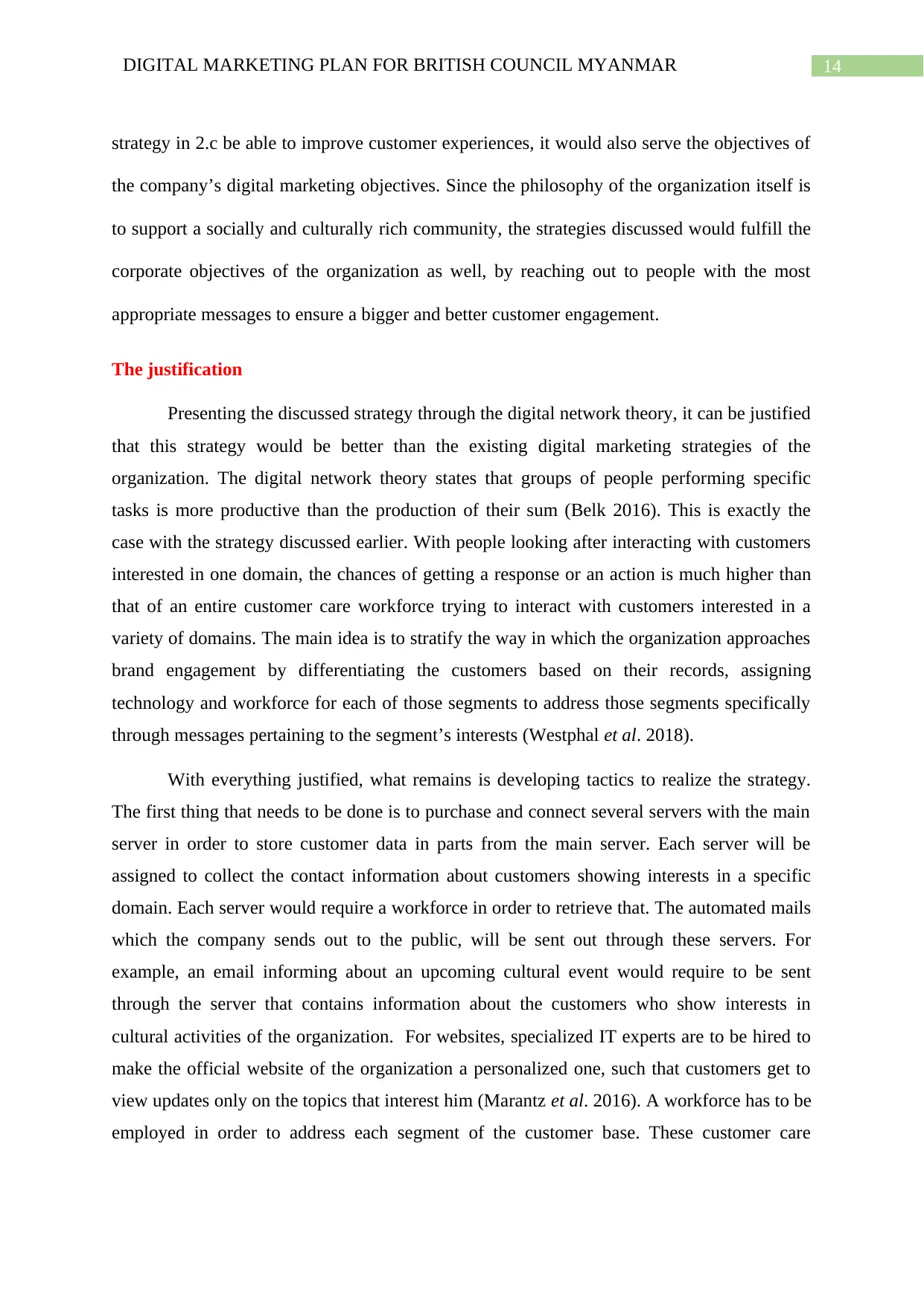
14DIGITAL MARKETING PLAN FOR BRITISH COUNCIL MYANMAR
strategy in 2.c be able to improve customer experiences, it would also serve the objectives of
the company’s digital marketing objectives. Since the philosophy of the organization itself is
to support a socially and culturally rich community, the strategies discussed would fulfill the
corporate objectives of the organization as well, by reaching out to people with the most
appropriate messages to ensure a bigger and better customer engagement.
The justification
Presenting the discussed strategy through the digital network theory, it can be justified
that this strategy would be better than the existing digital marketing strategies of the
organization. The digital network theory states that groups of people performing specific
tasks is more productive than the production of their sum (Belk 2016). This is exactly the
case with the strategy discussed earlier. With people looking after interacting with customers
interested in one domain, the chances of getting a response or an action is much higher than
that of an entire customer care workforce trying to interact with customers interested in a
variety of domains. The main idea is to stratify the way in which the organization approaches
brand engagement by differentiating the customers based on their records, assigning
technology and workforce for each of those segments to address those segments specifically
through messages pertaining to the segment’s interests (Westphal et al. 2018).
With everything justified, what remains is developing tactics to realize the strategy.
The first thing that needs to be done is to purchase and connect several servers with the main
server in order to store customer data in parts from the main server. Each server will be
assigned to collect the contact information about customers showing interests in a specific
domain. Each server would require a workforce in order to retrieve that. The automated mails
which the company sends out to the public, will be sent out through these servers. For
example, an email informing about an upcoming cultural event would require to be sent
through the server that contains information about the customers who show interests in
cultural activities of the organization. For websites, specialized IT experts are to be hired to
make the official website of the organization a personalized one, such that customers get to
view updates only on the topics that interest him (Marantz et al. 2016). A workforce has to be
employed in order to address each segment of the customer base. These customer care
strategy in 2.c be able to improve customer experiences, it would also serve the objectives of
the company’s digital marketing objectives. Since the philosophy of the organization itself is
to support a socially and culturally rich community, the strategies discussed would fulfill the
corporate objectives of the organization as well, by reaching out to people with the most
appropriate messages to ensure a bigger and better customer engagement.
The justification
Presenting the discussed strategy through the digital network theory, it can be justified
that this strategy would be better than the existing digital marketing strategies of the
organization. The digital network theory states that groups of people performing specific
tasks is more productive than the production of their sum (Belk 2016). This is exactly the
case with the strategy discussed earlier. With people looking after interacting with customers
interested in one domain, the chances of getting a response or an action is much higher than
that of an entire customer care workforce trying to interact with customers interested in a
variety of domains. The main idea is to stratify the way in which the organization approaches
brand engagement by differentiating the customers based on their records, assigning
technology and workforce for each of those segments to address those segments specifically
through messages pertaining to the segment’s interests (Westphal et al. 2018).
With everything justified, what remains is developing tactics to realize the strategy.
The first thing that needs to be done is to purchase and connect several servers with the main
server in order to store customer data in parts from the main server. Each server will be
assigned to collect the contact information about customers showing interests in a specific
domain. Each server would require a workforce in order to retrieve that. The automated mails
which the company sends out to the public, will be sent out through these servers. For
example, an email informing about an upcoming cultural event would require to be sent
through the server that contains information about the customers who show interests in
cultural activities of the organization. For websites, specialized IT experts are to be hired to
make the official website of the organization a personalized one, such that customers get to
view updates only on the topics that interest him (Marantz et al. 2016). A workforce has to be
employed in order to address each segment of the customer base. These customer care
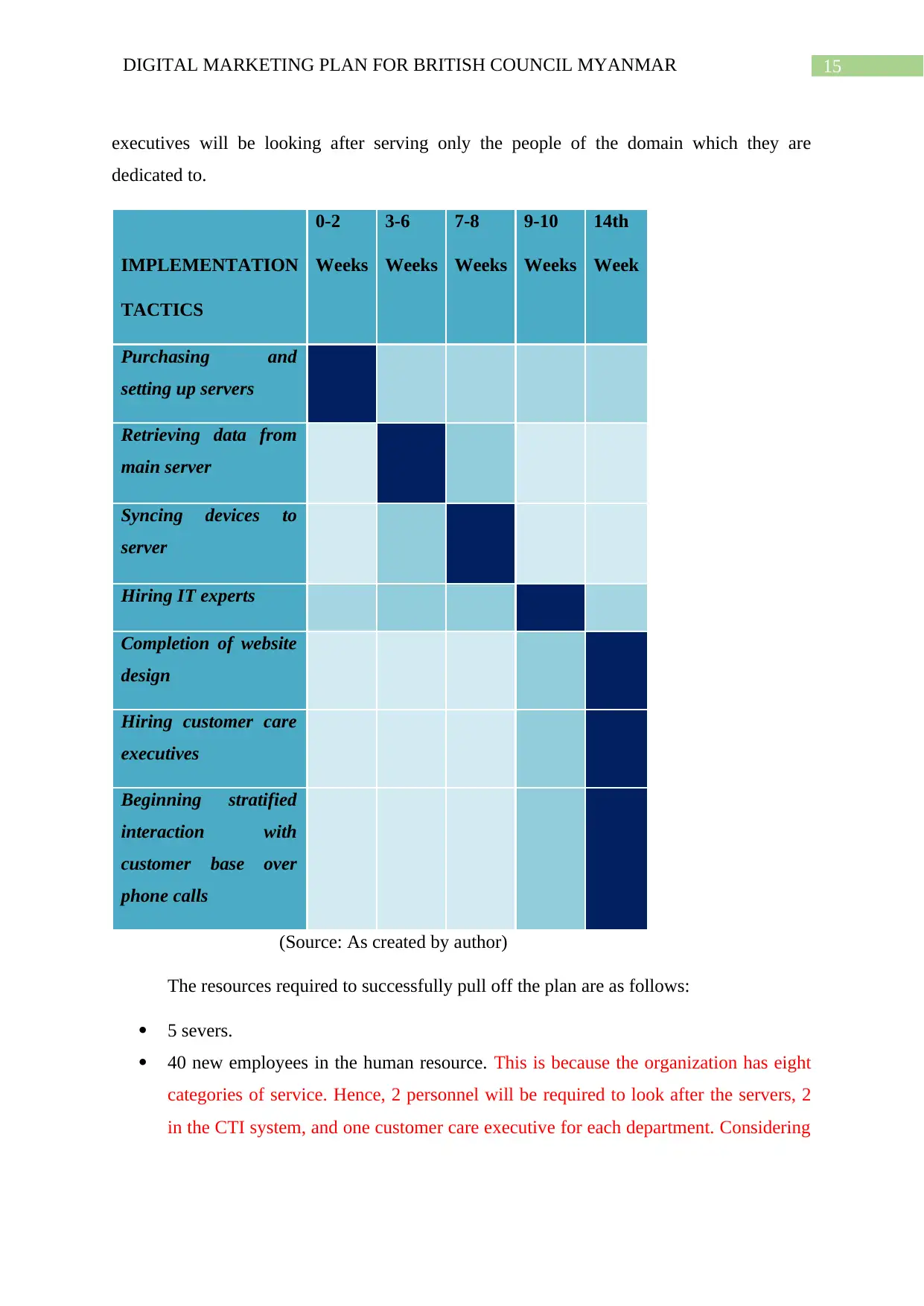
15DIGITAL MARKETING PLAN FOR BRITISH COUNCIL MYANMAR
executives will be looking after serving only the people of the domain which they are
dedicated to.
0-2 3-6 7-8 9-10 14th
IMPLEMENTATION
TACTICS
Weeks Weeks Weeks Weeks Week
Purchasing and
setting up servers
Retrieving data from
main server
Syncing devices to
server
Hiring IT experts
Completion of website
design
Hiring customer care
executives
Beginning stratified
interaction with
customer base over
phone calls
(Source: As created by author)
The resources required to successfully pull off the plan are as follows:
5 severs.
40 new employees in the human resource. This is because the organization has eight
categories of service. Hence, 2 personnel will be required to look after the servers, 2
in the CTI system, and one customer care executive for each department. Considering
executives will be looking after serving only the people of the domain which they are
dedicated to.
0-2 3-6 7-8 9-10 14th
IMPLEMENTATION
TACTICS
Weeks Weeks Weeks Weeks Week
Purchasing and
setting up servers
Retrieving data from
main server
Syncing devices to
server
Hiring IT experts
Completion of website
design
Hiring customer care
executives
Beginning stratified
interaction with
customer base over
phone calls
(Source: As created by author)
The resources required to successfully pull off the plan are as follows:
5 severs.
40 new employees in the human resource. This is because the organization has eight
categories of service. Hence, 2 personnel will be required to look after the servers, 2
in the CTI system, and one customer care executive for each department. Considering
Secure Best Marks with AI Grader
Need help grading? Try our AI Grader for instant feedback on your assignments.
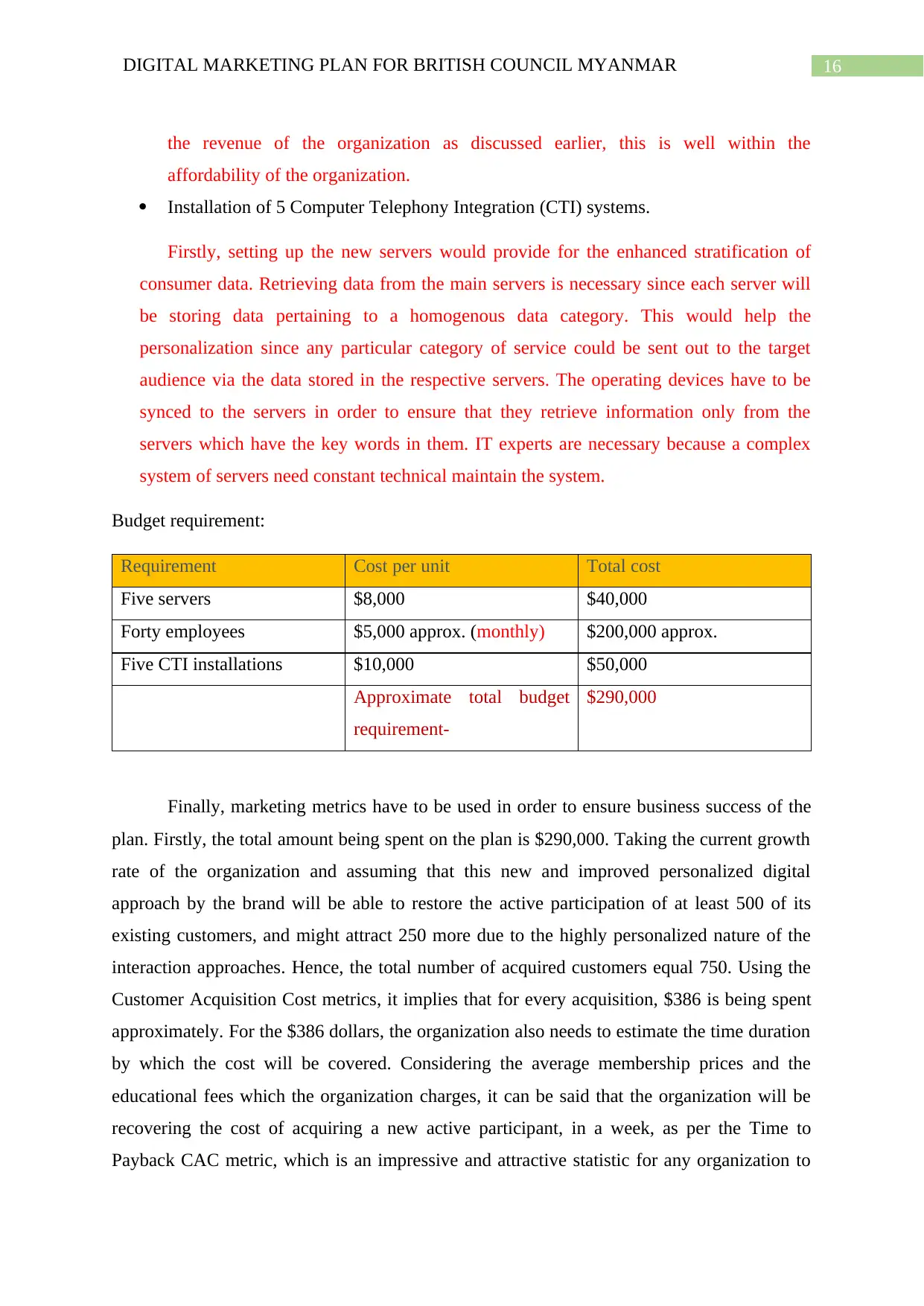
16DIGITAL MARKETING PLAN FOR BRITISH COUNCIL MYANMAR
the revenue of the organization as discussed earlier, this is well within the
affordability of the organization.
Installation of 5 Computer Telephony Integration (CTI) systems.
Firstly, setting up the new servers would provide for the enhanced stratification of
consumer data. Retrieving data from the main servers is necessary since each server will
be storing data pertaining to a homogenous data category. This would help the
personalization since any particular category of service could be sent out to the target
audience via the data stored in the respective servers. The operating devices have to be
synced to the servers in order to ensure that they retrieve information only from the
servers which have the key words in them. IT experts are necessary because a complex
system of servers need constant technical maintain the system.
Budget requirement:
Requirement Cost per unit Total cost
Five servers $8,000 $40,000
Forty employees $5,000 approx. (monthly) $200,000 approx.
Five CTI installations $10,000 $50,000
Approximate total budget
requirement-
$290,000
Finally, marketing metrics have to be used in order to ensure business success of the
plan. Firstly, the total amount being spent on the plan is $290,000. Taking the current growth
rate of the organization and assuming that this new and improved personalized digital
approach by the brand will be able to restore the active participation of at least 500 of its
existing customers, and might attract 250 more due to the highly personalized nature of the
interaction approaches. Hence, the total number of acquired customers equal 750. Using the
Customer Acquisition Cost metrics, it implies that for every acquisition, $386 is being spent
approximately. For the $386 dollars, the organization also needs to estimate the time duration
by which the cost will be covered. Considering the average membership prices and the
educational fees which the organization charges, it can be said that the organization will be
recovering the cost of acquiring a new active participant, in a week, as per the Time to
Payback CAC metric, which is an impressive and attractive statistic for any organization to
the revenue of the organization as discussed earlier, this is well within the
affordability of the organization.
Installation of 5 Computer Telephony Integration (CTI) systems.
Firstly, setting up the new servers would provide for the enhanced stratification of
consumer data. Retrieving data from the main servers is necessary since each server will
be storing data pertaining to a homogenous data category. This would help the
personalization since any particular category of service could be sent out to the target
audience via the data stored in the respective servers. The operating devices have to be
synced to the servers in order to ensure that they retrieve information only from the
servers which have the key words in them. IT experts are necessary because a complex
system of servers need constant technical maintain the system.
Budget requirement:
Requirement Cost per unit Total cost
Five servers $8,000 $40,000
Forty employees $5,000 approx. (monthly) $200,000 approx.
Five CTI installations $10,000 $50,000
Approximate total budget
requirement-
$290,000
Finally, marketing metrics have to be used in order to ensure business success of the
plan. Firstly, the total amount being spent on the plan is $290,000. Taking the current growth
rate of the organization and assuming that this new and improved personalized digital
approach by the brand will be able to restore the active participation of at least 500 of its
existing customers, and might attract 250 more due to the highly personalized nature of the
interaction approaches. Hence, the total number of acquired customers equal 750. Using the
Customer Acquisition Cost metrics, it implies that for every acquisition, $386 is being spent
approximately. For the $386 dollars, the organization also needs to estimate the time duration
by which the cost will be covered. Considering the average membership prices and the
educational fees which the organization charges, it can be said that the organization will be
recovering the cost of acquiring a new active participant, in a week, as per the Time to
Payback CAC metric, which is an impressive and attractive statistic for any organization to
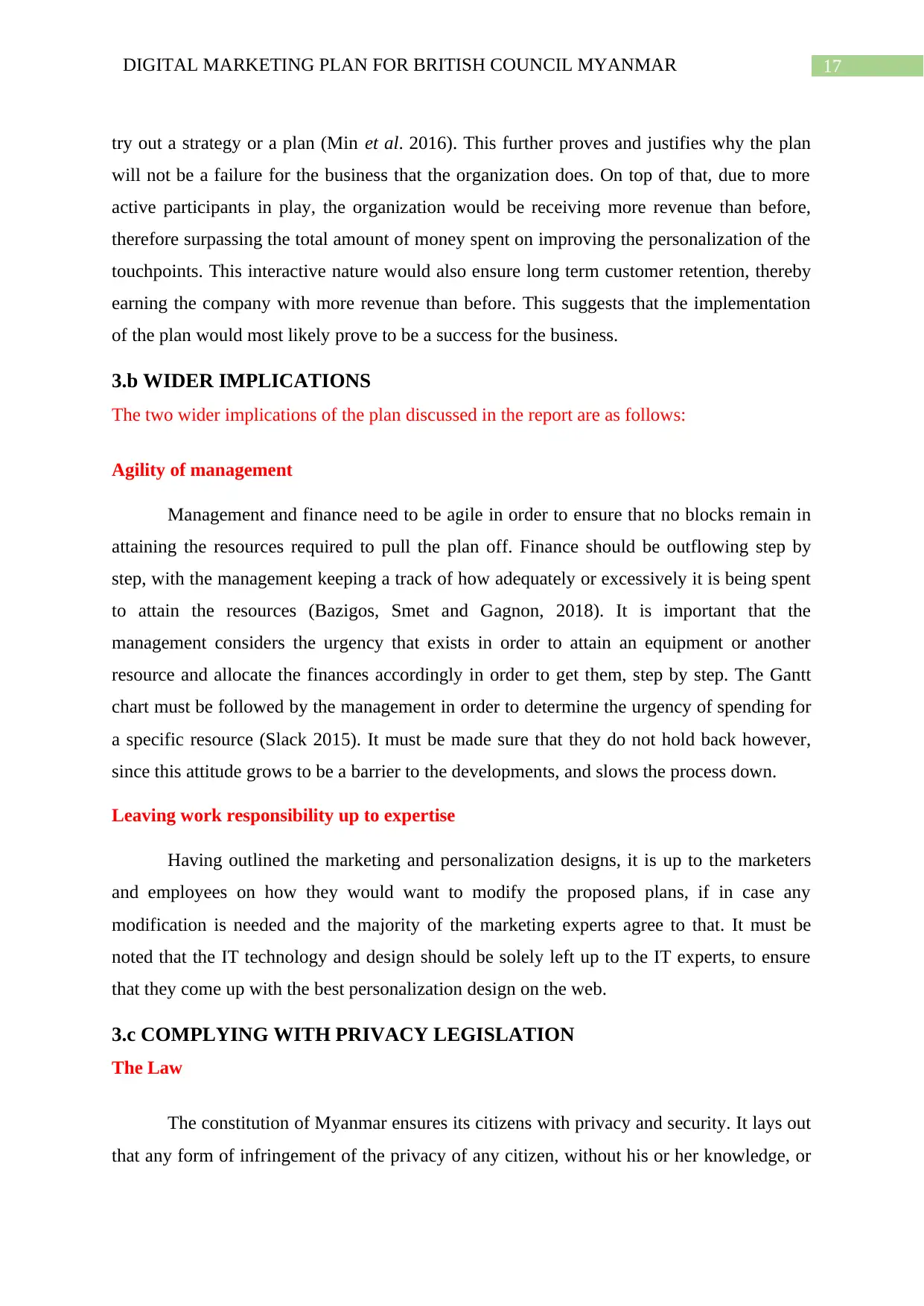
17DIGITAL MARKETING PLAN FOR BRITISH COUNCIL MYANMAR
try out a strategy or a plan (Min et al. 2016). This further proves and justifies why the plan
will not be a failure for the business that the organization does. On top of that, due to more
active participants in play, the organization would be receiving more revenue than before,
therefore surpassing the total amount of money spent on improving the personalization of the
touchpoints. This interactive nature would also ensure long term customer retention, thereby
earning the company with more revenue than before. This suggests that the implementation
of the plan would most likely prove to be a success for the business.
3.b WIDER IMPLICATIONS
The two wider implications of the plan discussed in the report are as follows:
Agility of management
Management and finance need to be agile in order to ensure that no blocks remain in
attaining the resources required to pull the plan off. Finance should be outflowing step by
step, with the management keeping a track of how adequately or excessively it is being spent
to attain the resources (Bazigos, Smet and Gagnon, 2018). It is important that the
management considers the urgency that exists in order to attain an equipment or another
resource and allocate the finances accordingly in order to get them, step by step. The Gantt
chart must be followed by the management in order to determine the urgency of spending for
a specific resource (Slack 2015). It must be made sure that they do not hold back however,
since this attitude grows to be a barrier to the developments, and slows the process down.
Leaving work responsibility up to expertise
Having outlined the marketing and personalization designs, it is up to the marketers
and employees on how they would want to modify the proposed plans, if in case any
modification is needed and the majority of the marketing experts agree to that. It must be
noted that the IT technology and design should be solely left up to the IT experts, to ensure
that they come up with the best personalization design on the web.
3.c COMPLYING WITH PRIVACY LEGISLATION
The Law
The constitution of Myanmar ensures its citizens with privacy and security. It lays out
that any form of infringement of the privacy of any citizen, without his or her knowledge, or
try out a strategy or a plan (Min et al. 2016). This further proves and justifies why the plan
will not be a failure for the business that the organization does. On top of that, due to more
active participants in play, the organization would be receiving more revenue than before,
therefore surpassing the total amount of money spent on improving the personalization of the
touchpoints. This interactive nature would also ensure long term customer retention, thereby
earning the company with more revenue than before. This suggests that the implementation
of the plan would most likely prove to be a success for the business.
3.b WIDER IMPLICATIONS
The two wider implications of the plan discussed in the report are as follows:
Agility of management
Management and finance need to be agile in order to ensure that no blocks remain in
attaining the resources required to pull the plan off. Finance should be outflowing step by
step, with the management keeping a track of how adequately or excessively it is being spent
to attain the resources (Bazigos, Smet and Gagnon, 2018). It is important that the
management considers the urgency that exists in order to attain an equipment or another
resource and allocate the finances accordingly in order to get them, step by step. The Gantt
chart must be followed by the management in order to determine the urgency of spending for
a specific resource (Slack 2015). It must be made sure that they do not hold back however,
since this attitude grows to be a barrier to the developments, and slows the process down.
Leaving work responsibility up to expertise
Having outlined the marketing and personalization designs, it is up to the marketers
and employees on how they would want to modify the proposed plans, if in case any
modification is needed and the majority of the marketing experts agree to that. It must be
noted that the IT technology and design should be solely left up to the IT experts, to ensure
that they come up with the best personalization design on the web.
3.c COMPLYING WITH PRIVACY LEGISLATION
The Law
The constitution of Myanmar ensures its citizens with privacy and security. It lays out
that any form of infringement of the privacy of any citizen, without his or her knowledge, or
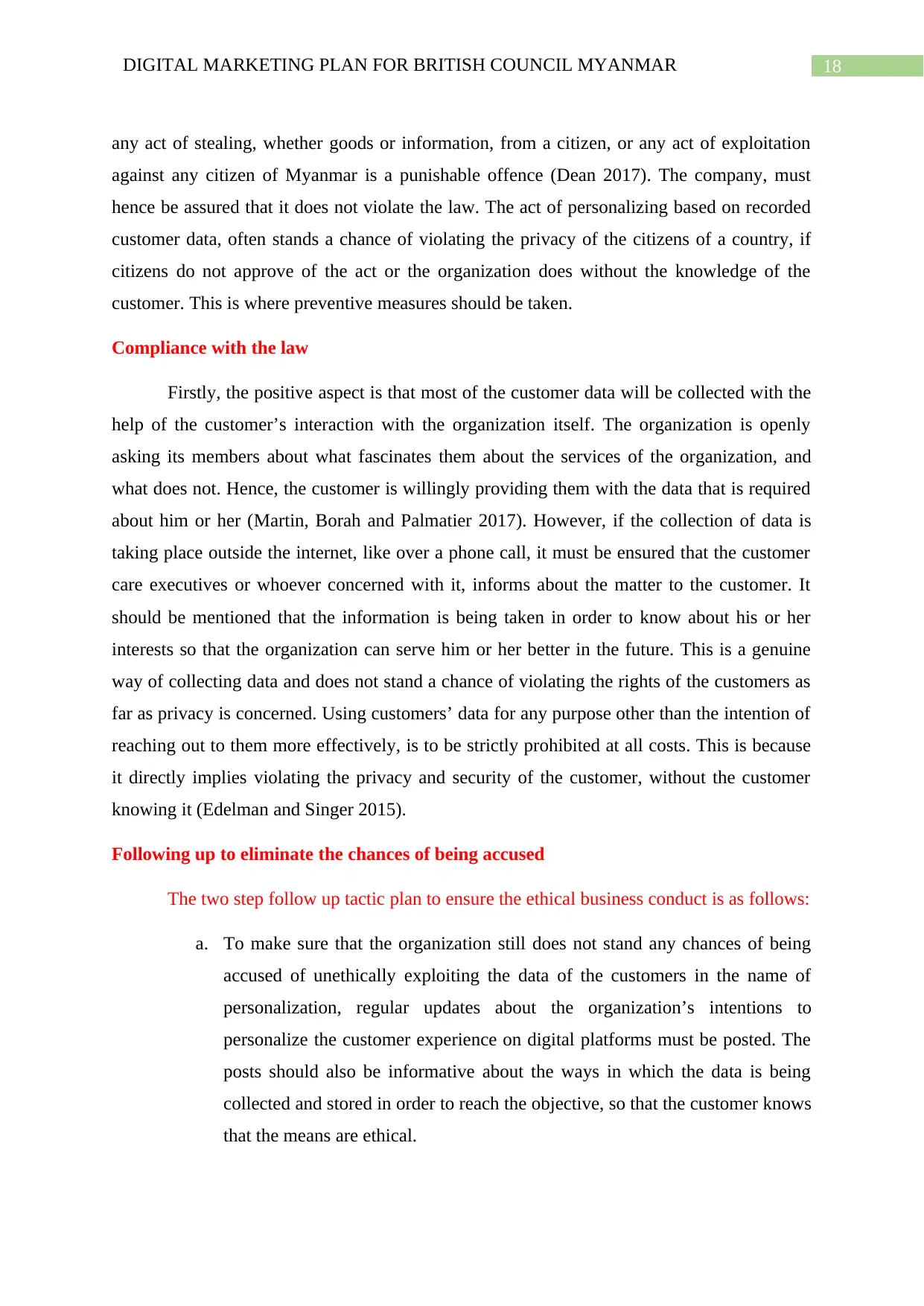
18DIGITAL MARKETING PLAN FOR BRITISH COUNCIL MYANMAR
any act of stealing, whether goods or information, from a citizen, or any act of exploitation
against any citizen of Myanmar is a punishable offence (Dean 2017). The company, must
hence be assured that it does not violate the law. The act of personalizing based on recorded
customer data, often stands a chance of violating the privacy of the citizens of a country, if
citizens do not approve of the act or the organization does without the knowledge of the
customer. This is where preventive measures should be taken.
Compliance with the law
Firstly, the positive aspect is that most of the customer data will be collected with the
help of the customer’s interaction with the organization itself. The organization is openly
asking its members about what fascinates them about the services of the organization, and
what does not. Hence, the customer is willingly providing them with the data that is required
about him or her (Martin, Borah and Palmatier 2017). However, if the collection of data is
taking place outside the internet, like over a phone call, it must be ensured that the customer
care executives or whoever concerned with it, informs about the matter to the customer. It
should be mentioned that the information is being taken in order to know about his or her
interests so that the organization can serve him or her better in the future. This is a genuine
way of collecting data and does not stand a chance of violating the rights of the customers as
far as privacy is concerned. Using customers’ data for any purpose other than the intention of
reaching out to them more effectively, is to be strictly prohibited at all costs. This is because
it directly implies violating the privacy and security of the customer, without the customer
knowing it (Edelman and Singer 2015).
Following up to eliminate the chances of being accused
The two step follow up tactic plan to ensure the ethical business conduct is as follows:
a. To make sure that the organization still does not stand any chances of being
accused of unethically exploiting the data of the customers in the name of
personalization, regular updates about the organization’s intentions to
personalize the customer experience on digital platforms must be posted. The
posts should also be informative about the ways in which the data is being
collected and stored in order to reach the objective, so that the customer knows
that the means are ethical.
any act of stealing, whether goods or information, from a citizen, or any act of exploitation
against any citizen of Myanmar is a punishable offence (Dean 2017). The company, must
hence be assured that it does not violate the law. The act of personalizing based on recorded
customer data, often stands a chance of violating the privacy of the citizens of a country, if
citizens do not approve of the act or the organization does without the knowledge of the
customer. This is where preventive measures should be taken.
Compliance with the law
Firstly, the positive aspect is that most of the customer data will be collected with the
help of the customer’s interaction with the organization itself. The organization is openly
asking its members about what fascinates them about the services of the organization, and
what does not. Hence, the customer is willingly providing them with the data that is required
about him or her (Martin, Borah and Palmatier 2017). However, if the collection of data is
taking place outside the internet, like over a phone call, it must be ensured that the customer
care executives or whoever concerned with it, informs about the matter to the customer. It
should be mentioned that the information is being taken in order to know about his or her
interests so that the organization can serve him or her better in the future. This is a genuine
way of collecting data and does not stand a chance of violating the rights of the customers as
far as privacy is concerned. Using customers’ data for any purpose other than the intention of
reaching out to them more effectively, is to be strictly prohibited at all costs. This is because
it directly implies violating the privacy and security of the customer, without the customer
knowing it (Edelman and Singer 2015).
Following up to eliminate the chances of being accused
The two step follow up tactic plan to ensure the ethical business conduct is as follows:
a. To make sure that the organization still does not stand any chances of being
accused of unethically exploiting the data of the customers in the name of
personalization, regular updates about the organization’s intentions to
personalize the customer experience on digital platforms must be posted. The
posts should also be informative about the ways in which the data is being
collected and stored in order to reach the objective, so that the customer knows
that the means are ethical.
Paraphrase This Document
Need a fresh take? Get an instant paraphrase of this document with our AI Paraphraser
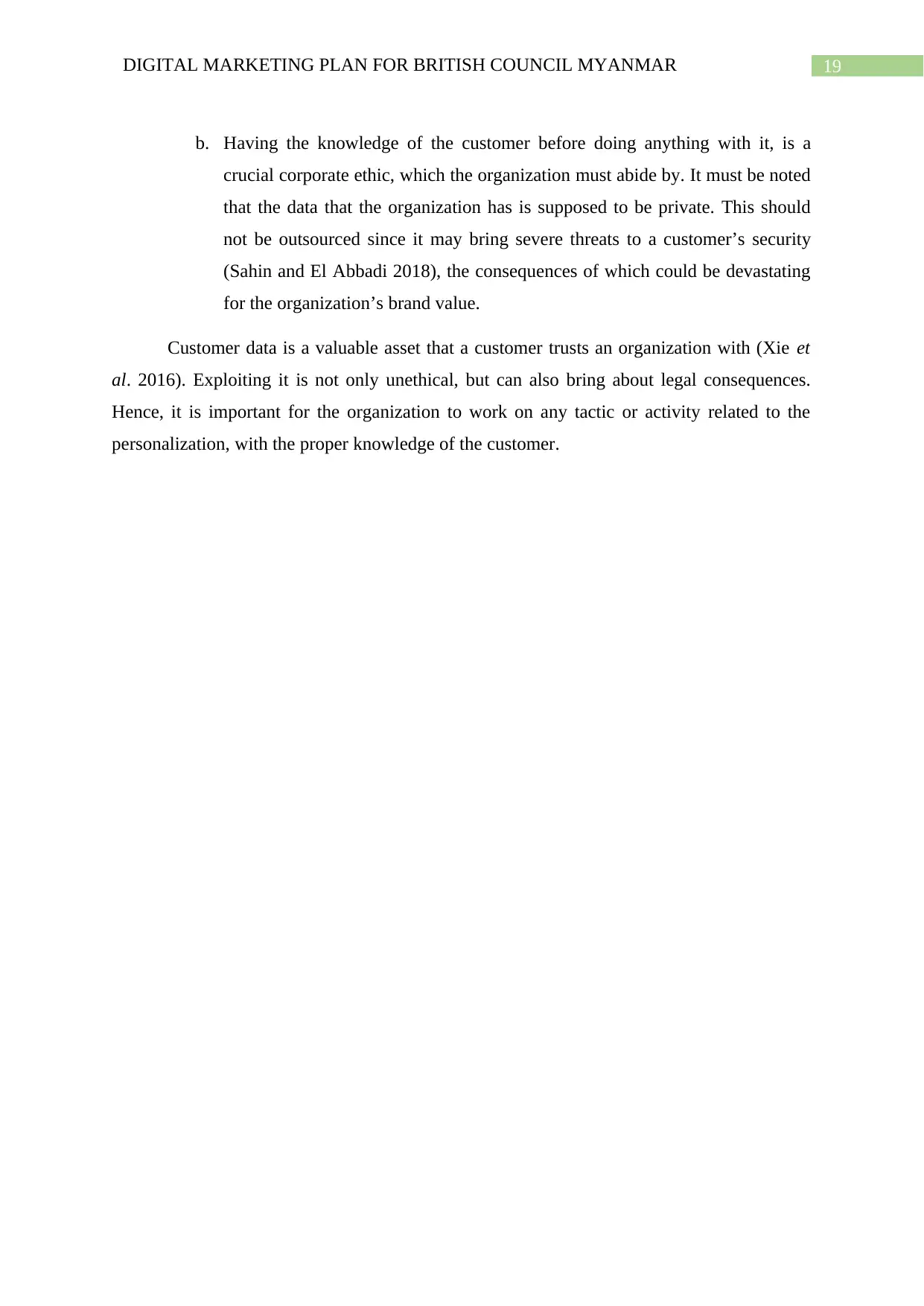
19DIGITAL MARKETING PLAN FOR BRITISH COUNCIL MYANMAR
b. Having the knowledge of the customer before doing anything with it, is a
crucial corporate ethic, which the organization must abide by. It must be noted
that the data that the organization has is supposed to be private. This should
not be outsourced since it may bring severe threats to a customer’s security
(Sahin and El Abbadi 2018), the consequences of which could be devastating
for the organization’s brand value.
Customer data is a valuable asset that a customer trusts an organization with (Xie et
al. 2016). Exploiting it is not only unethical, but can also bring about legal consequences.
Hence, it is important for the organization to work on any tactic or activity related to the
personalization, with the proper knowledge of the customer.
b. Having the knowledge of the customer before doing anything with it, is a
crucial corporate ethic, which the organization must abide by. It must be noted
that the data that the organization has is supposed to be private. This should
not be outsourced since it may bring severe threats to a customer’s security
(Sahin and El Abbadi 2018), the consequences of which could be devastating
for the organization’s brand value.
Customer data is a valuable asset that a customer trusts an organization with (Xie et
al. 2016). Exploiting it is not only unethical, but can also bring about legal consequences.
Hence, it is important for the organization to work on any tactic or activity related to the
personalization, with the proper knowledge of the customer.
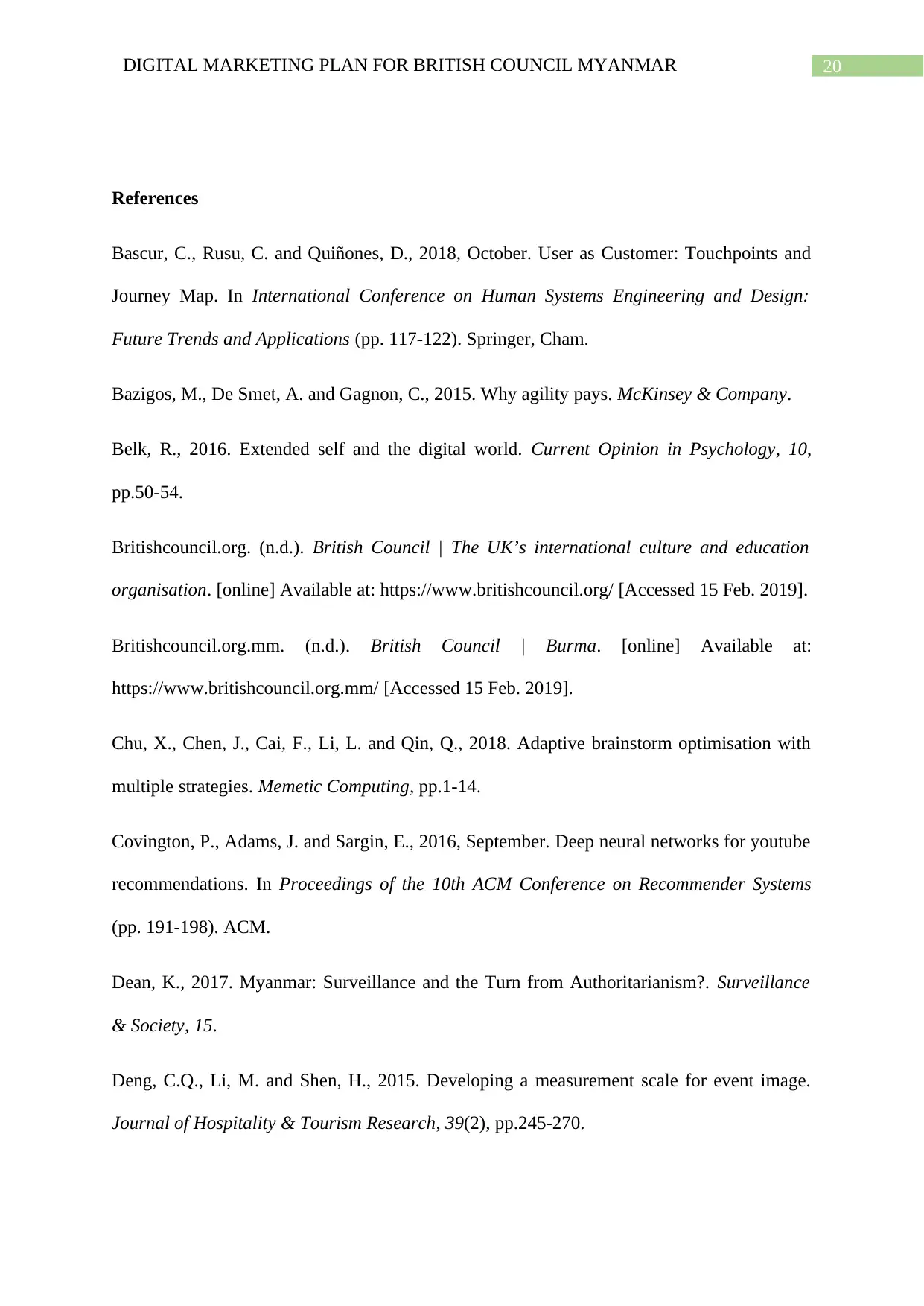
20DIGITAL MARKETING PLAN FOR BRITISH COUNCIL MYANMAR
References
Bascur, C., Rusu, C. and Quiñones, D., 2018, October. User as Customer: Touchpoints and
Journey Map. In International Conference on Human Systems Engineering and Design:
Future Trends and Applications (pp. 117-122). Springer, Cham.
Bazigos, M., De Smet, A. and Gagnon, C., 2015. Why agility pays. McKinsey & Company.
Belk, R., 2016. Extended self and the digital world. Current Opinion in Psychology, 10,
pp.50-54.
Britishcouncil.org. (n.d.). British Council | The UK’s international culture and education
organisation. [online] Available at: https://www.britishcouncil.org/ [Accessed 15 Feb. 2019].
Britishcouncil.org.mm. (n.d.). British Council | Burma. [online] Available at:
https://www.britishcouncil.org.mm/ [Accessed 15 Feb. 2019].
Chu, X., Chen, J., Cai, F., Li, L. and Qin, Q., 2018. Adaptive brainstorm optimisation with
multiple strategies. Memetic Computing, pp.1-14.
Covington, P., Adams, J. and Sargin, E., 2016, September. Deep neural networks for youtube
recommendations. In Proceedings of the 10th ACM Conference on Recommender Systems
(pp. 191-198). ACM.
Dean, K., 2017. Myanmar: Surveillance and the Turn from Authoritarianism?. Surveillance
& Society, 15.
Deng, C.Q., Li, M. and Shen, H., 2015. Developing a measurement scale for event image.
Journal of Hospitality & Tourism Research, 39(2), pp.245-270.
References
Bascur, C., Rusu, C. and Quiñones, D., 2018, October. User as Customer: Touchpoints and
Journey Map. In International Conference on Human Systems Engineering and Design:
Future Trends and Applications (pp. 117-122). Springer, Cham.
Bazigos, M., De Smet, A. and Gagnon, C., 2015. Why agility pays. McKinsey & Company.
Belk, R., 2016. Extended self and the digital world. Current Opinion in Psychology, 10,
pp.50-54.
Britishcouncil.org. (n.d.). British Council | The UK’s international culture and education
organisation. [online] Available at: https://www.britishcouncil.org/ [Accessed 15 Feb. 2019].
Britishcouncil.org.mm. (n.d.). British Council | Burma. [online] Available at:
https://www.britishcouncil.org.mm/ [Accessed 15 Feb. 2019].
Chu, X., Chen, J., Cai, F., Li, L. and Qin, Q., 2018. Adaptive brainstorm optimisation with
multiple strategies. Memetic Computing, pp.1-14.
Covington, P., Adams, J. and Sargin, E., 2016, September. Deep neural networks for youtube
recommendations. In Proceedings of the 10th ACM Conference on Recommender Systems
(pp. 191-198). ACM.
Dean, K., 2017. Myanmar: Surveillance and the Turn from Authoritarianism?. Surveillance
& Society, 15.
Deng, C.Q., Li, M. and Shen, H., 2015. Developing a measurement scale for event image.
Journal of Hospitality & Tourism Research, 39(2), pp.245-270.

21DIGITAL MARKETING PLAN FOR BRITISH COUNCIL MYANMAR
Edelman, D.C. and Singer, M., 2015. Competing on customer journeys. Harvard Business
Review, 93(11), pp.88-100.
Elizabeth, E. and Banks, J., 2018. A STUDY OF TEACHERS’SELF-PERCEIVED
EMOTIONAL INTELLIGENCE WITH THEIR DEMOGRAPHIC PROFILES IN PINYA
SANYAE INSTITUTE OF EDUCATION, YANGON, MYANMAR. Scholar: Human
Sciences, 10(1), p.187.
Furnham, A., 2017. Methods in Recruitment and Selection. The Wiley Blackwell Handbook
of the Psychology of Recruitment, Selection and Employee Retention, p.202.
Haraty, M. and McGrenere, J., 2016, June. Designing for advanced personalization in
personal task management. In Proceedings of the 2016 ACM Conference on Designing
Interactive Systems (pp. 239-250). ACM.
Harcourt, C., 2018. Myanmar Students Seeking Higher Education in the United States:
Illuminating Meaning in Stories of Lived Experience (Doctoral dissertation, Prescott
College).
Harmeling, C.M., Moffett, J.W., Arnold, M.J. and Carlson, B.D., 2017. Toward a theory of
customer engagement marketing. Journal of the Academy of Marketing Science, 45(3),
pp.312-335.
Kandampully, J., Zhang, T. and Bilgihan, A., 2015. Customer loyalty: a review and future
directions with a special focus on the hospitality industry. International Journal of
Contemporary Hospitality Management, 27(3), pp.379-414.
Keeter, S., Hatley, N., Kennedy, C. and Lau, A., 2017. What low response rates mean for
telephone surveys. Pew Research Center, 15.
Edelman, D.C. and Singer, M., 2015. Competing on customer journeys. Harvard Business
Review, 93(11), pp.88-100.
Elizabeth, E. and Banks, J., 2018. A STUDY OF TEACHERS’SELF-PERCEIVED
EMOTIONAL INTELLIGENCE WITH THEIR DEMOGRAPHIC PROFILES IN PINYA
SANYAE INSTITUTE OF EDUCATION, YANGON, MYANMAR. Scholar: Human
Sciences, 10(1), p.187.
Furnham, A., 2017. Methods in Recruitment and Selection. The Wiley Blackwell Handbook
of the Psychology of Recruitment, Selection and Employee Retention, p.202.
Haraty, M. and McGrenere, J., 2016, June. Designing for advanced personalization in
personal task management. In Proceedings of the 2016 ACM Conference on Designing
Interactive Systems (pp. 239-250). ACM.
Harcourt, C., 2018. Myanmar Students Seeking Higher Education in the United States:
Illuminating Meaning in Stories of Lived Experience (Doctoral dissertation, Prescott
College).
Harmeling, C.M., Moffett, J.W., Arnold, M.J. and Carlson, B.D., 2017. Toward a theory of
customer engagement marketing. Journal of the Academy of Marketing Science, 45(3),
pp.312-335.
Kandampully, J., Zhang, T. and Bilgihan, A., 2015. Customer loyalty: a review and future
directions with a special focus on the hospitality industry. International Journal of
Contemporary Hospitality Management, 27(3), pp.379-414.
Keeter, S., Hatley, N., Kennedy, C. and Lau, A., 2017. What low response rates mean for
telephone surveys. Pew Research Center, 15.
Secure Best Marks with AI Grader
Need help grading? Try our AI Grader for instant feedback on your assignments.
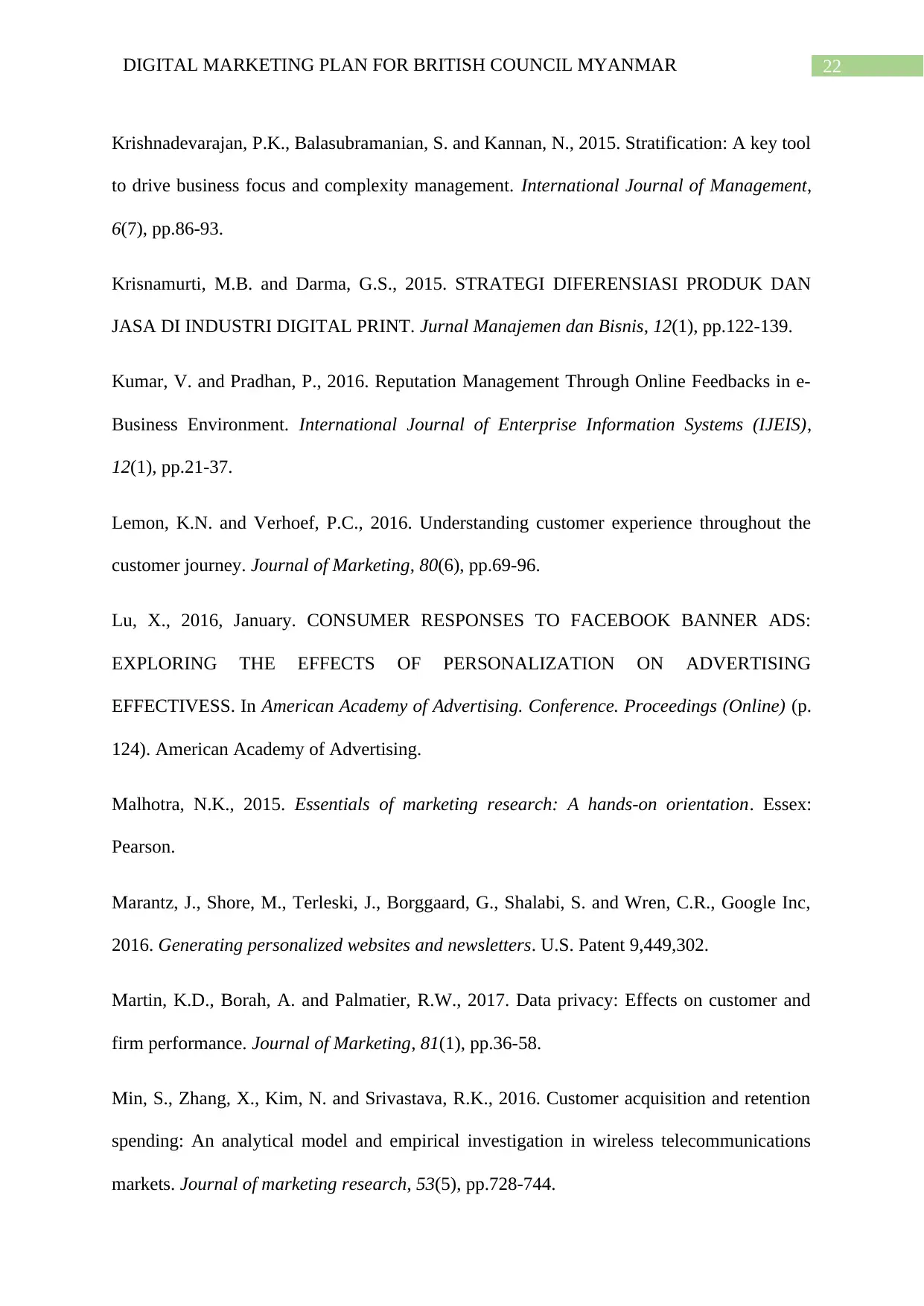
22DIGITAL MARKETING PLAN FOR BRITISH COUNCIL MYANMAR
Krishnadevarajan, P.K., Balasubramanian, S. and Kannan, N., 2015. Stratification: A key tool
to drive business focus and complexity management. International Journal of Management,
6(7), pp.86-93.
Krisnamurti, M.B. and Darma, G.S., 2015. STRATEGI DIFERENSIASI PRODUK DAN
JASA DI INDUSTRI DIGITAL PRINT. Jurnal Manajemen dan Bisnis, 12(1), pp.122-139.
Kumar, V. and Pradhan, P., 2016. Reputation Management Through Online Feedbacks in e-
Business Environment. International Journal of Enterprise Information Systems (IJEIS),
12(1), pp.21-37.
Lemon, K.N. and Verhoef, P.C., 2016. Understanding customer experience throughout the
customer journey. Journal of Marketing, 80(6), pp.69-96.
Lu, X., 2016, January. CONSUMER RESPONSES TO FACEBOOK BANNER ADS:
EXPLORING THE EFFECTS OF PERSONALIZATION ON ADVERTISING
EFFECTIVESS. In American Academy of Advertising. Conference. Proceedings (Online) (p.
124). American Academy of Advertising.
Malhotra, N.K., 2015. Essentials of marketing research: A hands-on orientation. Essex:
Pearson.
Marantz, J., Shore, M., Terleski, J., Borggaard, G., Shalabi, S. and Wren, C.R., Google Inc,
2016. Generating personalized websites and newsletters. U.S. Patent 9,449,302.
Martin, K.D., Borah, A. and Palmatier, R.W., 2017. Data privacy: Effects on customer and
firm performance. Journal of Marketing, 81(1), pp.36-58.
Min, S., Zhang, X., Kim, N. and Srivastava, R.K., 2016. Customer acquisition and retention
spending: An analytical model and empirical investigation in wireless telecommunications
markets. Journal of marketing research, 53(5), pp.728-744.
Krishnadevarajan, P.K., Balasubramanian, S. and Kannan, N., 2015. Stratification: A key tool
to drive business focus and complexity management. International Journal of Management,
6(7), pp.86-93.
Krisnamurti, M.B. and Darma, G.S., 2015. STRATEGI DIFERENSIASI PRODUK DAN
JASA DI INDUSTRI DIGITAL PRINT. Jurnal Manajemen dan Bisnis, 12(1), pp.122-139.
Kumar, V. and Pradhan, P., 2016. Reputation Management Through Online Feedbacks in e-
Business Environment. International Journal of Enterprise Information Systems (IJEIS),
12(1), pp.21-37.
Lemon, K.N. and Verhoef, P.C., 2016. Understanding customer experience throughout the
customer journey. Journal of Marketing, 80(6), pp.69-96.
Lu, X., 2016, January. CONSUMER RESPONSES TO FACEBOOK BANNER ADS:
EXPLORING THE EFFECTS OF PERSONALIZATION ON ADVERTISING
EFFECTIVESS. In American Academy of Advertising. Conference. Proceedings (Online) (p.
124). American Academy of Advertising.
Malhotra, N.K., 2015. Essentials of marketing research: A hands-on orientation. Essex:
Pearson.
Marantz, J., Shore, M., Terleski, J., Borggaard, G., Shalabi, S. and Wren, C.R., Google Inc,
2016. Generating personalized websites and newsletters. U.S. Patent 9,449,302.
Martin, K.D., Borah, A. and Palmatier, R.W., 2017. Data privacy: Effects on customer and
firm performance. Journal of Marketing, 81(1), pp.36-58.
Min, S., Zhang, X., Kim, N. and Srivastava, R.K., 2016. Customer acquisition and retention
spending: An analytical model and empirical investigation in wireless telecommunications
markets. Journal of marketing research, 53(5), pp.728-744.
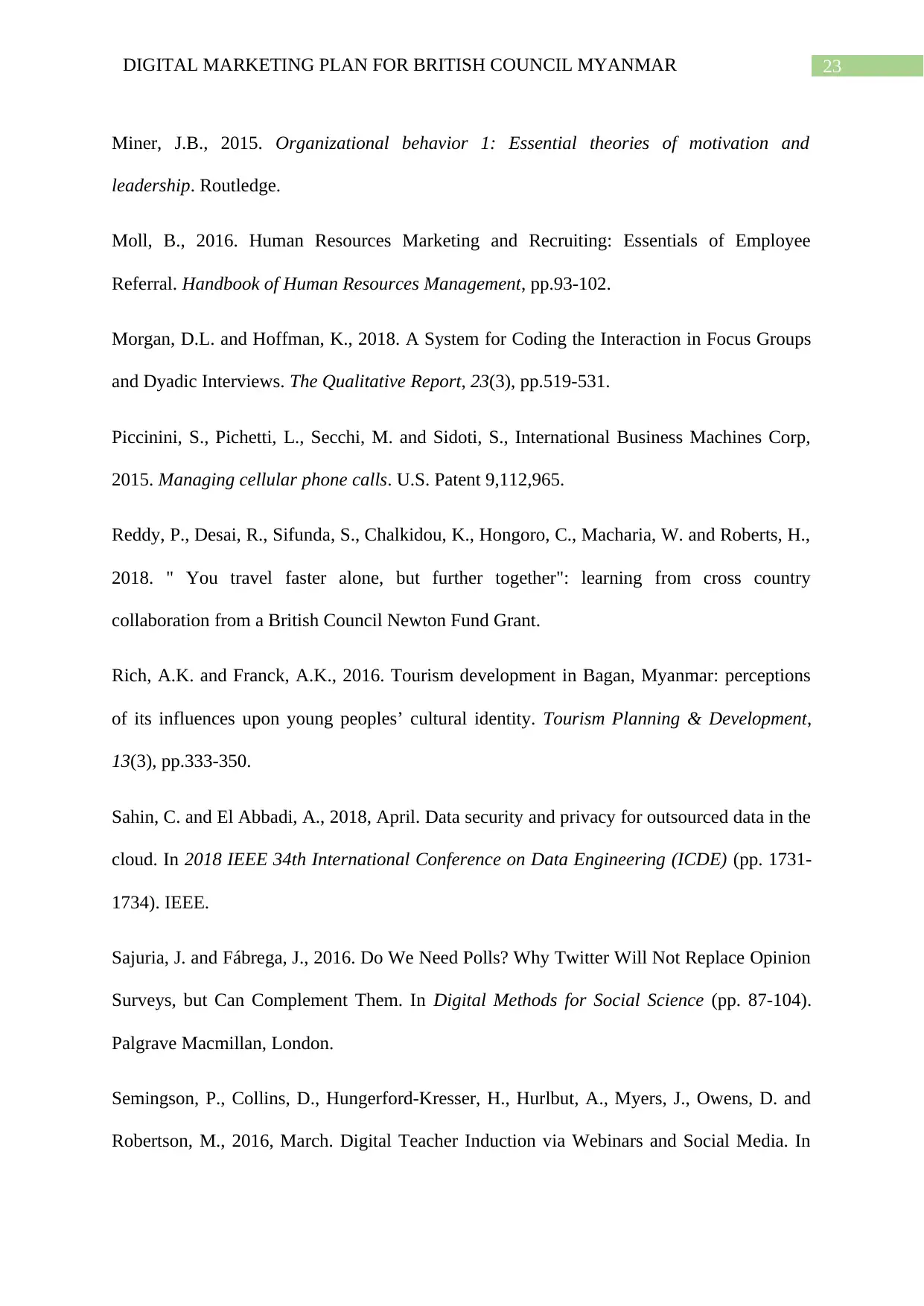
23DIGITAL MARKETING PLAN FOR BRITISH COUNCIL MYANMAR
Miner, J.B., 2015. Organizational behavior 1: Essential theories of motivation and
leadership. Routledge.
Moll, B., 2016. Human Resources Marketing and Recruiting: Essentials of Employee
Referral. Handbook of Human Resources Management, pp.93-102.
Morgan, D.L. and Hoffman, K., 2018. A System for Coding the Interaction in Focus Groups
and Dyadic Interviews. The Qualitative Report, 23(3), pp.519-531.
Piccinini, S., Pichetti, L., Secchi, M. and Sidoti, S., International Business Machines Corp,
2015. Managing cellular phone calls. U.S. Patent 9,112,965.
Reddy, P., Desai, R., Sifunda, S., Chalkidou, K., Hongoro, C., Macharia, W. and Roberts, H.,
2018. " You travel faster alone, but further together": learning from cross country
collaboration from a British Council Newton Fund Grant.
Rich, A.K. and Franck, A.K., 2016. Tourism development in Bagan, Myanmar: perceptions
of its influences upon young peoples’ cultural identity. Tourism Planning & Development,
13(3), pp.333-350.
Sahin, C. and El Abbadi, A., 2018, April. Data security and privacy for outsourced data in the
cloud. In 2018 IEEE 34th International Conference on Data Engineering (ICDE) (pp. 1731-
1734). IEEE.
Sajuria, J. and Fábrega, J., 2016. Do We Need Polls? Why Twitter Will Not Replace Opinion
Surveys, but Can Complement Them. In Digital Methods for Social Science (pp. 87-104).
Palgrave Macmillan, London.
Semingson, P., Collins, D., Hungerford-Kresser, H., Hurlbut, A., Myers, J., Owens, D. and
Robertson, M., 2016, March. Digital Teacher Induction via Webinars and Social Media. In
Miner, J.B., 2015. Organizational behavior 1: Essential theories of motivation and
leadership. Routledge.
Moll, B., 2016. Human Resources Marketing and Recruiting: Essentials of Employee
Referral. Handbook of Human Resources Management, pp.93-102.
Morgan, D.L. and Hoffman, K., 2018. A System for Coding the Interaction in Focus Groups
and Dyadic Interviews. The Qualitative Report, 23(3), pp.519-531.
Piccinini, S., Pichetti, L., Secchi, M. and Sidoti, S., International Business Machines Corp,
2015. Managing cellular phone calls. U.S. Patent 9,112,965.
Reddy, P., Desai, R., Sifunda, S., Chalkidou, K., Hongoro, C., Macharia, W. and Roberts, H.,
2018. " You travel faster alone, but further together": learning from cross country
collaboration from a British Council Newton Fund Grant.
Rich, A.K. and Franck, A.K., 2016. Tourism development in Bagan, Myanmar: perceptions
of its influences upon young peoples’ cultural identity. Tourism Planning & Development,
13(3), pp.333-350.
Sahin, C. and El Abbadi, A., 2018, April. Data security and privacy for outsourced data in the
cloud. In 2018 IEEE 34th International Conference on Data Engineering (ICDE) (pp. 1731-
1734). IEEE.
Sajuria, J. and Fábrega, J., 2016. Do We Need Polls? Why Twitter Will Not Replace Opinion
Surveys, but Can Complement Them. In Digital Methods for Social Science (pp. 87-104).
Palgrave Macmillan, London.
Semingson, P., Collins, D., Hungerford-Kresser, H., Hurlbut, A., Myers, J., Owens, D. and
Robertson, M., 2016, March. Digital Teacher Induction via Webinars and Social Media. In
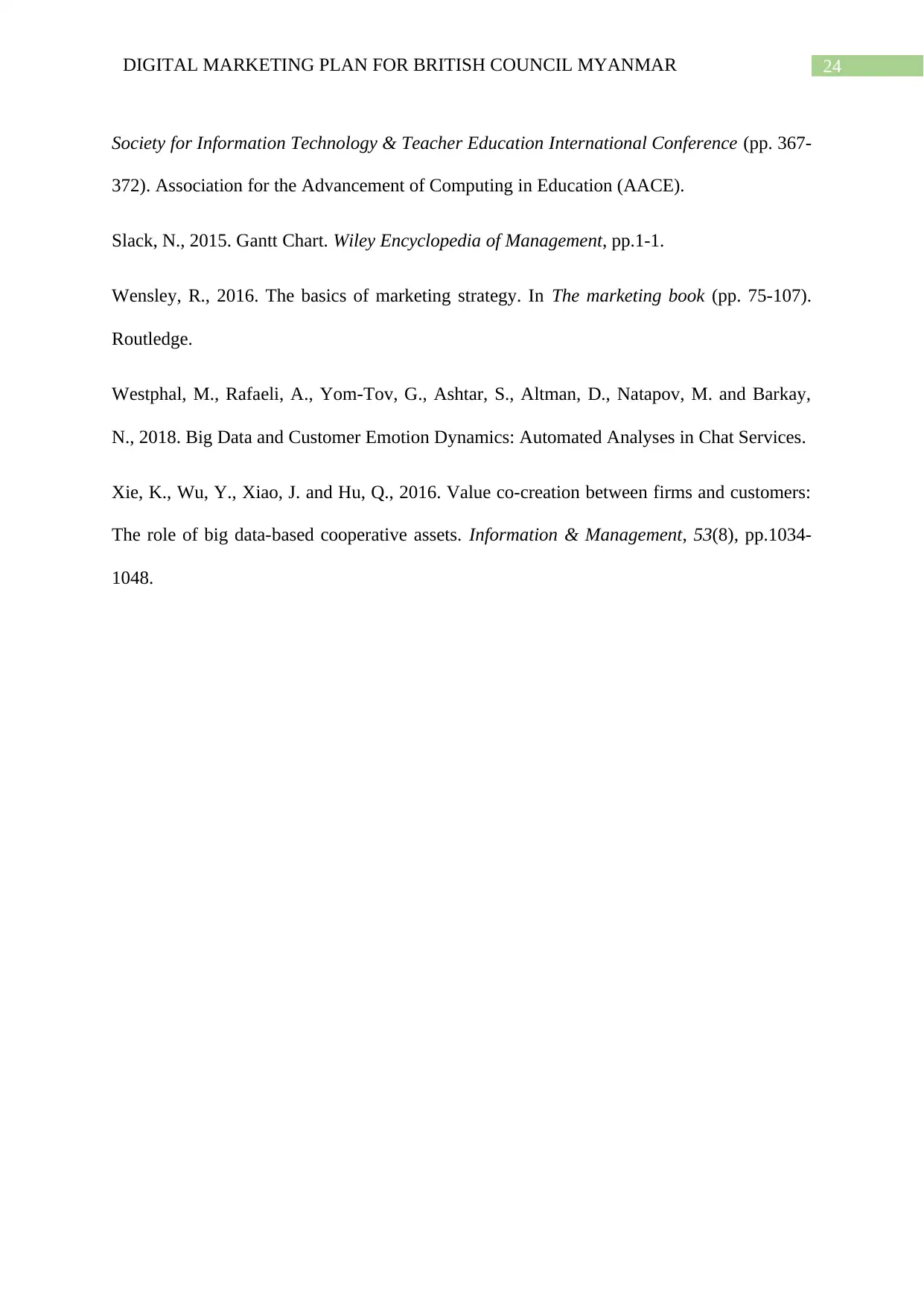
24DIGITAL MARKETING PLAN FOR BRITISH COUNCIL MYANMAR
Society for Information Technology & Teacher Education International Conference (pp. 367-
372). Association for the Advancement of Computing in Education (AACE).
Slack, N., 2015. Gantt Chart. Wiley Encyclopedia of Management, pp.1-1.
Wensley, R., 2016. The basics of marketing strategy. In The marketing book (pp. 75-107).
Routledge.
Westphal, M., Rafaeli, A., Yom-Tov, G., Ashtar, S., Altman, D., Natapov, M. and Barkay,
N., 2018. Big Data and Customer Emotion Dynamics: Automated Analyses in Chat Services.
Xie, K., Wu, Y., Xiao, J. and Hu, Q., 2016. Value co-creation between firms and customers:
The role of big data-based cooperative assets. Information & Management, 53(8), pp.1034-
1048.
Society for Information Technology & Teacher Education International Conference (pp. 367-
372). Association for the Advancement of Computing in Education (AACE).
Slack, N., 2015. Gantt Chart. Wiley Encyclopedia of Management, pp.1-1.
Wensley, R., 2016. The basics of marketing strategy. In The marketing book (pp. 75-107).
Routledge.
Westphal, M., Rafaeli, A., Yom-Tov, G., Ashtar, S., Altman, D., Natapov, M. and Barkay,
N., 2018. Big Data and Customer Emotion Dynamics: Automated Analyses in Chat Services.
Xie, K., Wu, Y., Xiao, J. and Hu, Q., 2016. Value co-creation between firms and customers:
The role of big data-based cooperative assets. Information & Management, 53(8), pp.1034-
1048.
1 out of 25
Related Documents
Your All-in-One AI-Powered Toolkit for Academic Success.
+13062052269
info@desklib.com
Available 24*7 on WhatsApp / Email
![[object Object]](/_next/static/media/star-bottom.7253800d.svg)
Unlock your academic potential
© 2024 | Zucol Services PVT LTD | All rights reserved.
